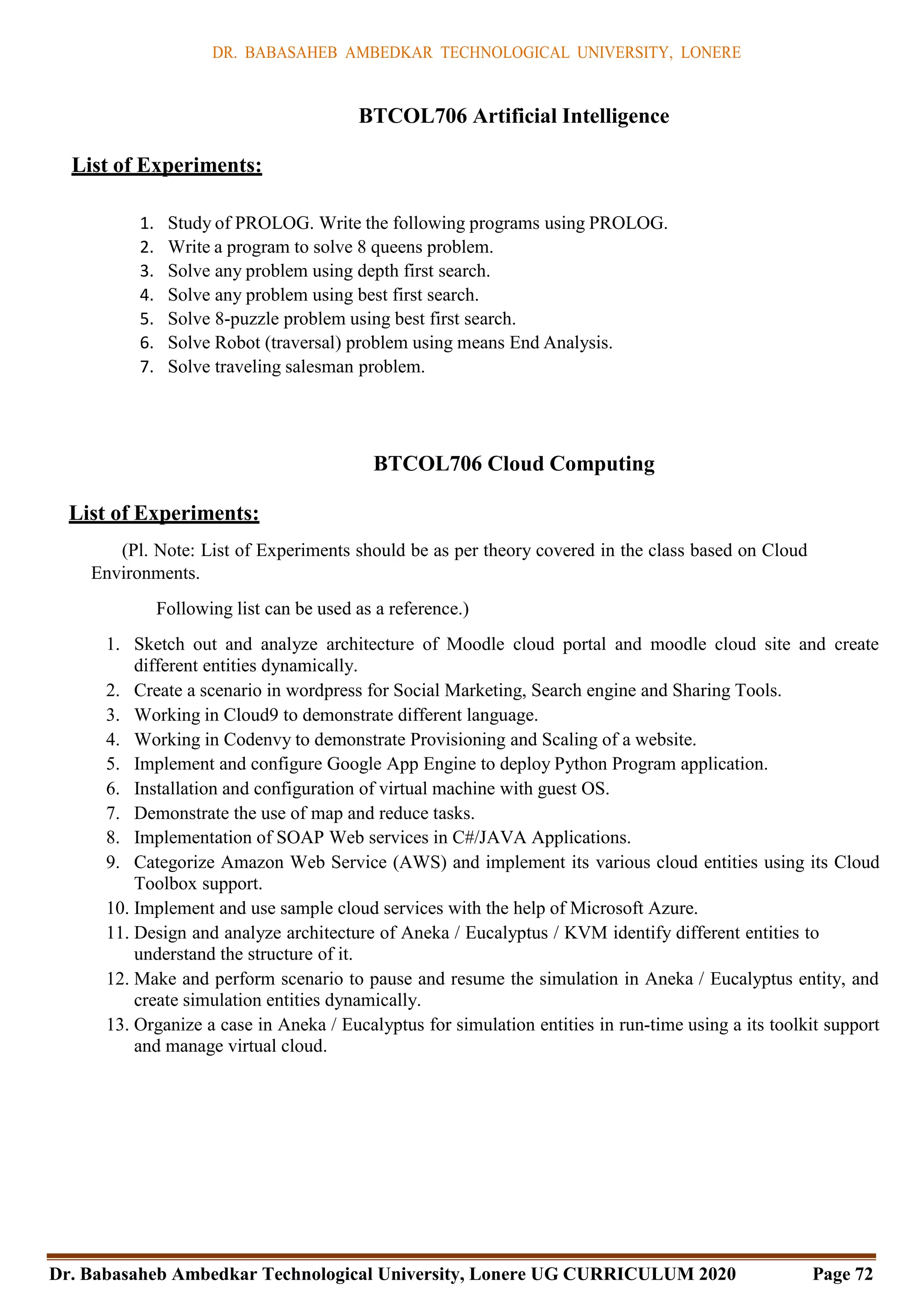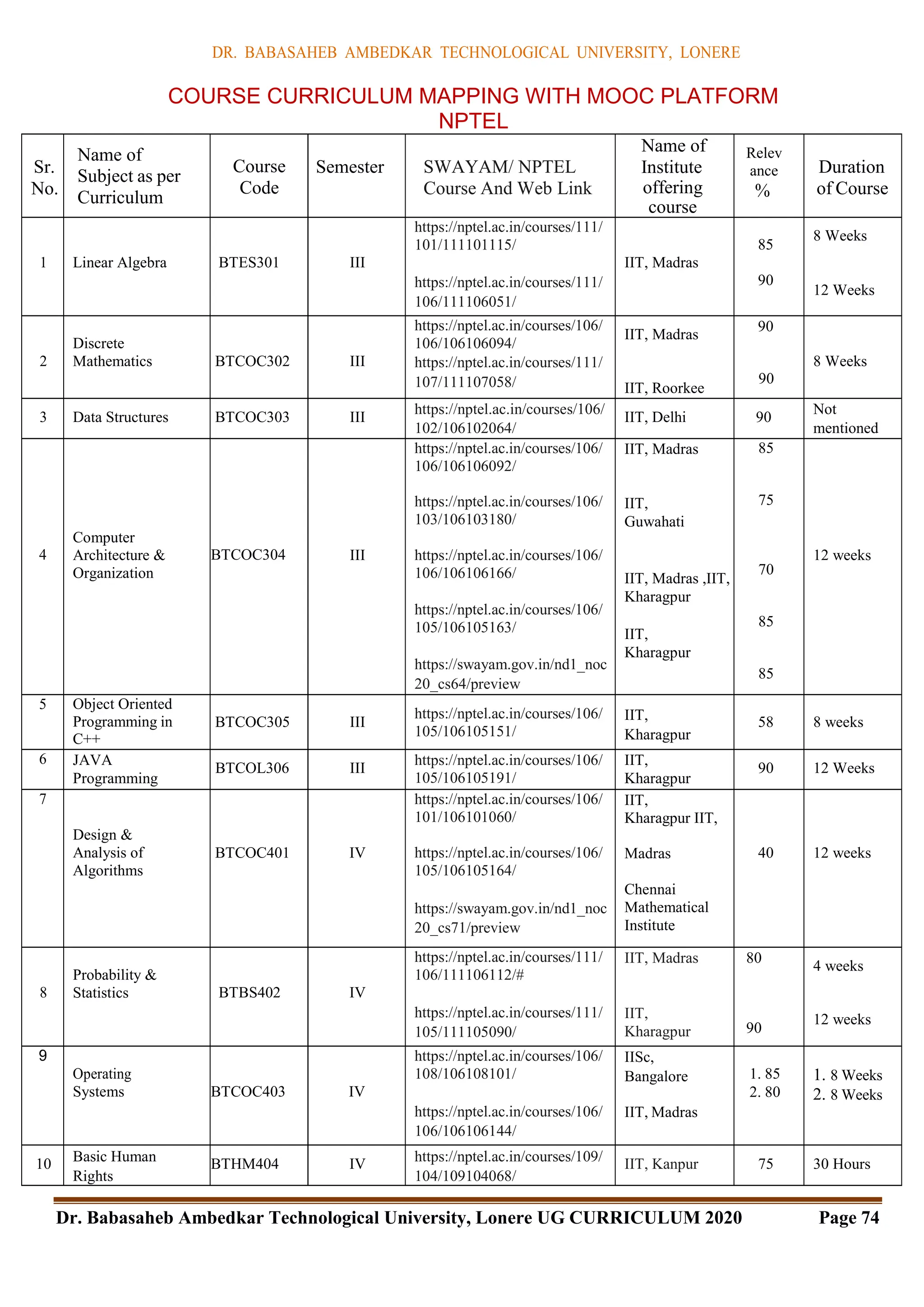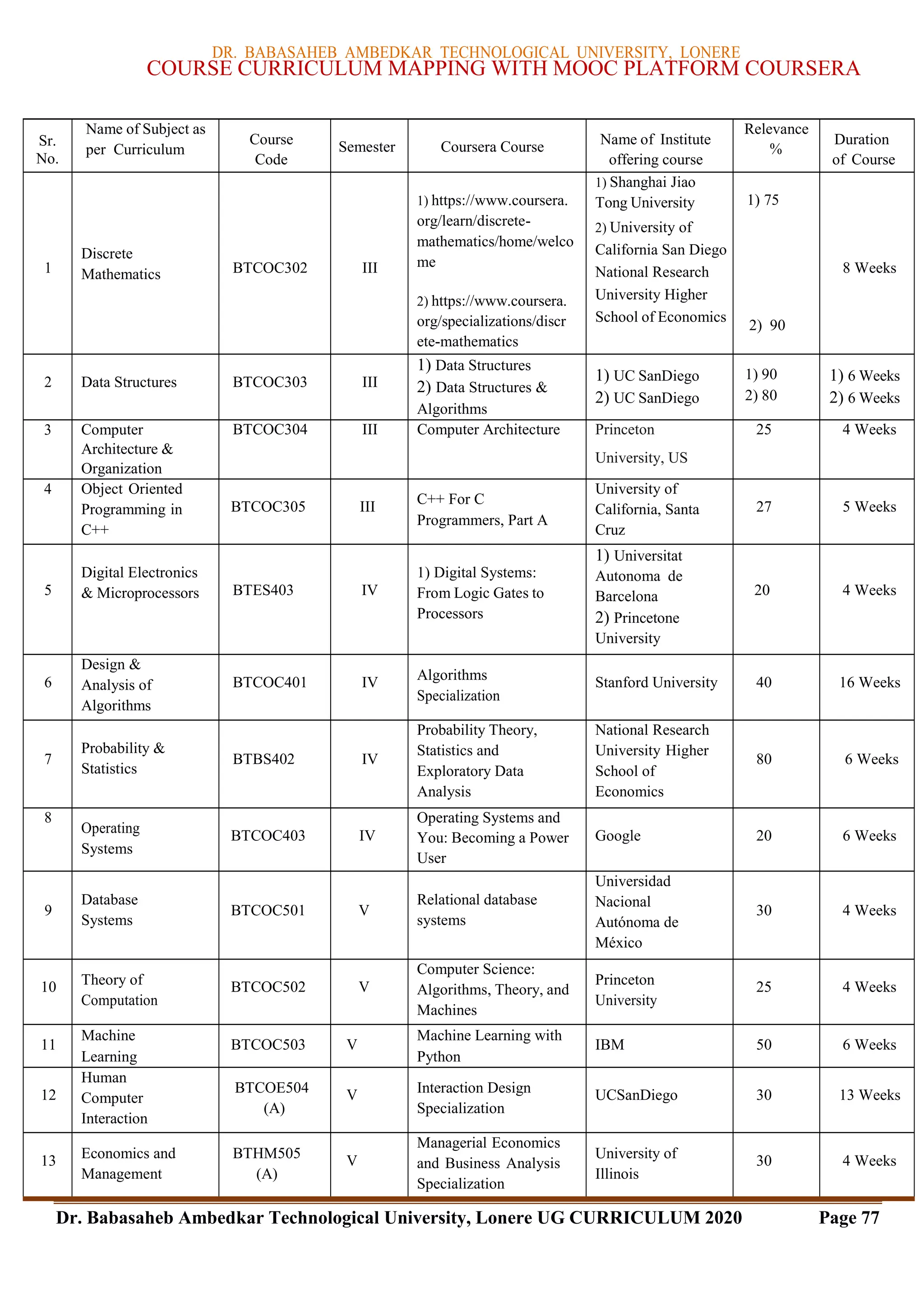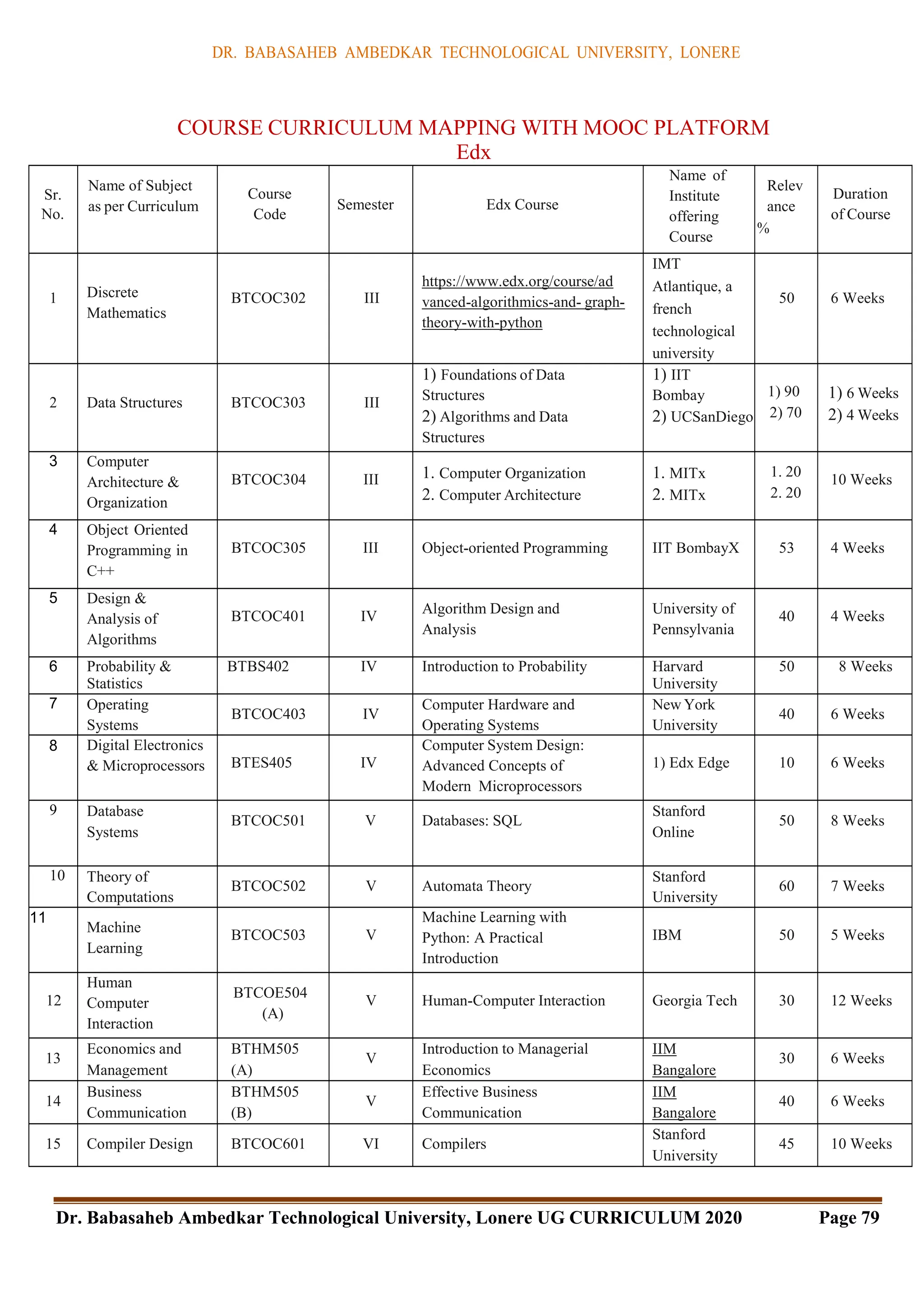Dr. Babasaheb Ambedkar Technological University, Lonere outlines the curriculum and regulations for B.Tech and M.Tech programs starting from the 2020-2021 academic year. The document includes details on course duration, evaluation systems, attendance requirements, course prerequisites, and credit transfer policies. Additionally, it specifies requirements for honors and minor degrees, aimed at enhancing student employability through cross-discipline studies.
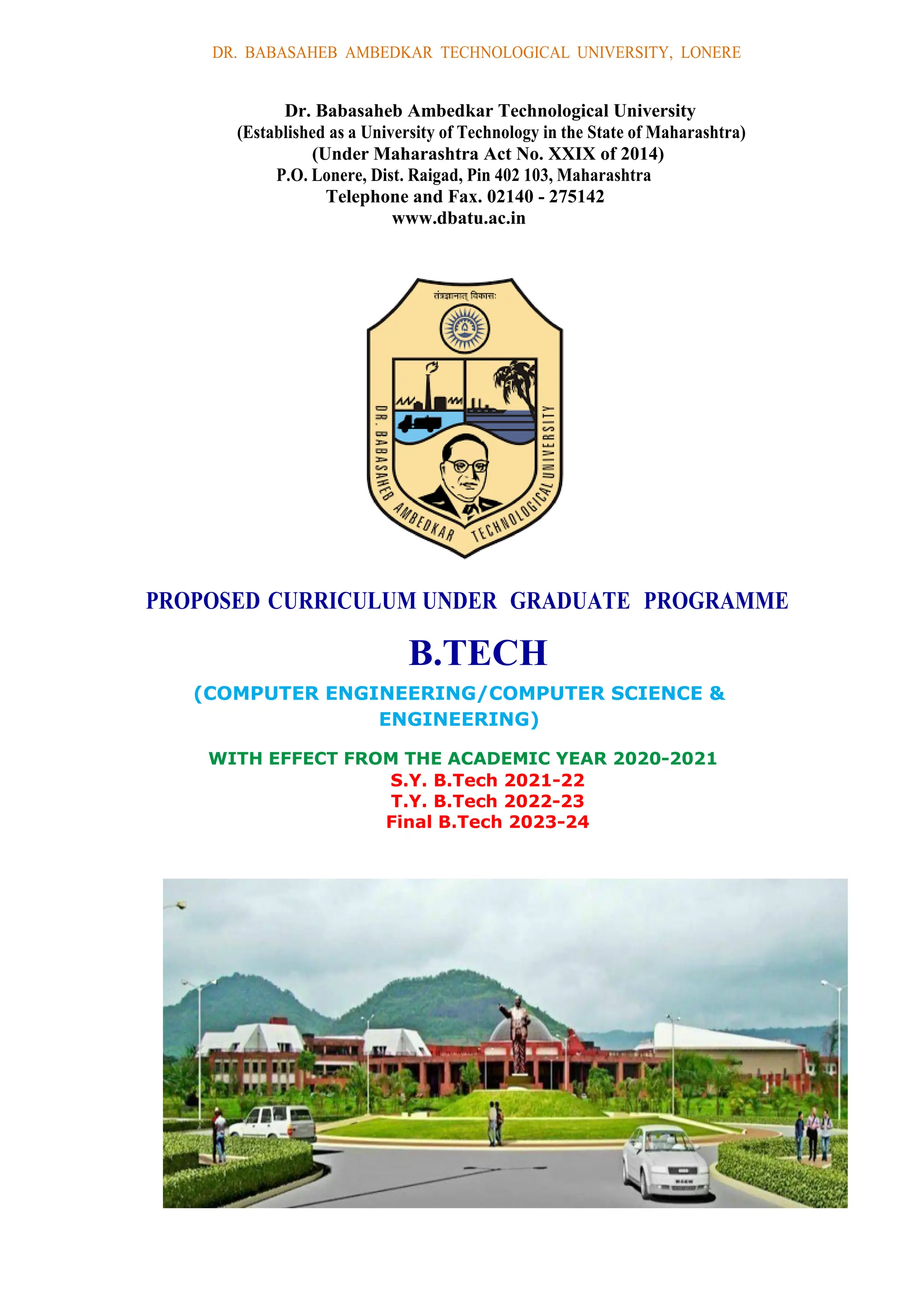
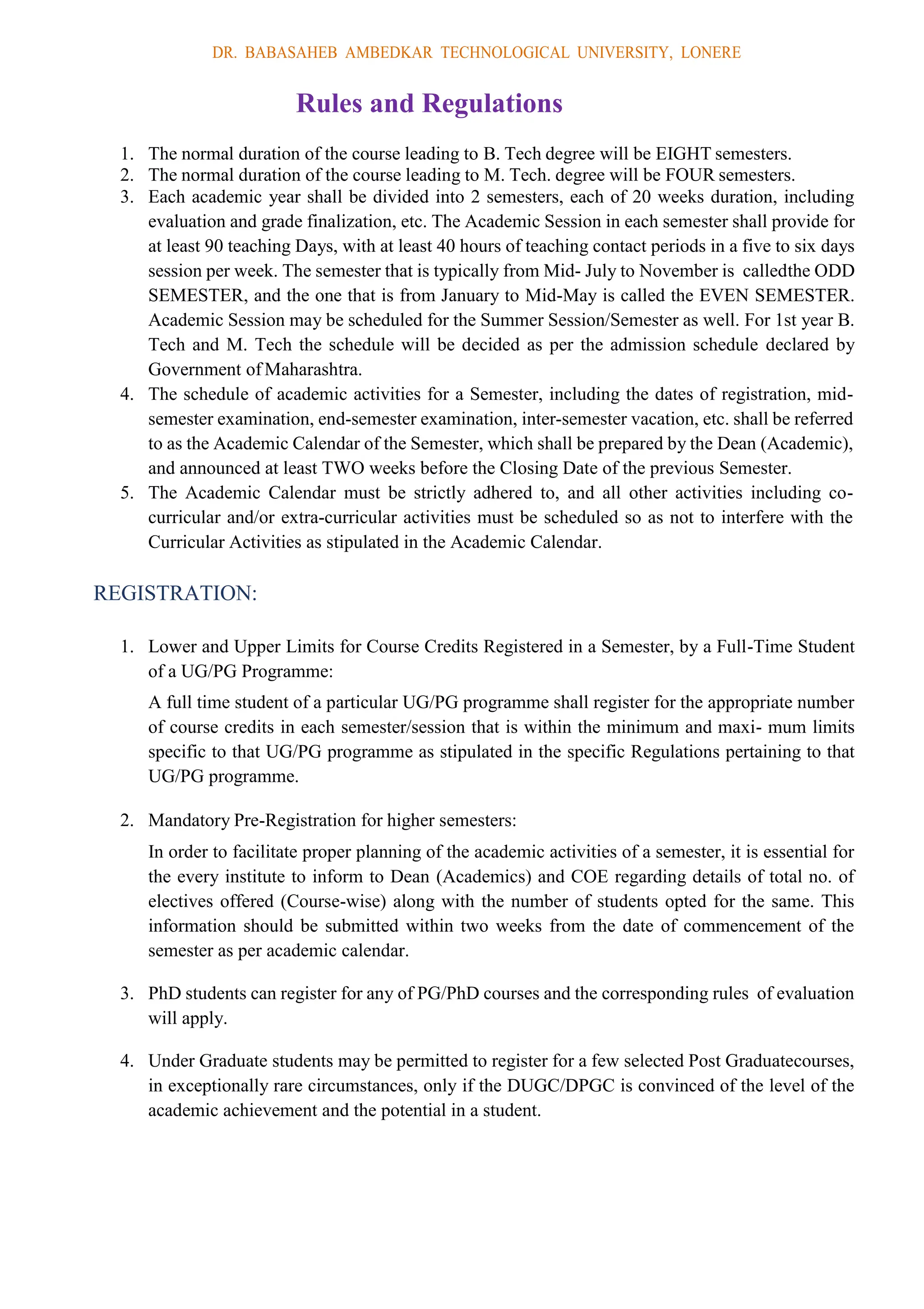
![DR. BABASAHEB AMBEDKAR TECHNOLOGICAL UNIVERSITY, LONERE
COURSE PRE-REQUISITES:
1. In order to register for some courses, it may be required either to have exposure in, or to have
completed satisfactorily, or to have prior earned credits in, some specifiedcourses.
2. Students who do not register on the day announced for the purpose may be permitted LATE
REGISTRATION up to the notified day in academic calendar on payment of late fee.
3. REGISTRATION IN ABSENTIA will be allowed only in exceptional cases with the approval
of the Dean (Academic) / Principal.
4. A student will be permitted to register in the next semester only if he fulfills the following
conditions:
(a) Satisfied all the Academic Requirements to continue with the programme
ofStudies without termination
(b) Cleared all Institute, Hostel and Library dues and fines (if any) of the previous semesters;
(c) Paid all required advance payments of the Institute and hostel for the current semester;
(d) Not been debarred from registering on any specific ground by the Institute.
EVALUATION SYSTEM:
1. Absolute grading system based on absolute marks as indicated below will be
implemented from academic year 2019-20, starting from I year B.Tech.
Percentage of
Marks
Letter grade Grade point
91-100 EX 10.0
86-90 AA 9.0
81-85 AB 8.5
76-80 BB 8.0
71-75 BC 7.5
66-70 CC 7.0
61-65 CD 6.5
56-60 DD 6.0
51-55 DE 5.5
40-50 EE 5.0
<40 EF 0.0
2. Class is awarded based on CGPA of all eighth semester of B.Tech Program.
CGPA for pass is minimum 5.0
CGPA upto < 5.50 Pass Class
CGPA ≥ 5.50 & < 6.00 Second Class
CGPA ≥ 6.00 & < 7.50 First Class
CGPA ≥ 7.50 Distinction
[Percentage of Marks = CGPA*10.0]
3. A total of 100 Marks for each theory course are distributed as follows:
1 Mid Semester Exam (MSE) Marks 20
2 Continuous Assessment Marks 20
3 End Semester Examination (ESE)Marks 60](https://image.slidesharecdn.com/dbatusyllabus-240425025908-3b234bc1/75/Dbatu-syllabus-basic-human-rights-of-SY-computer-science-engineering-of-DBATU-3-2048.jpg)
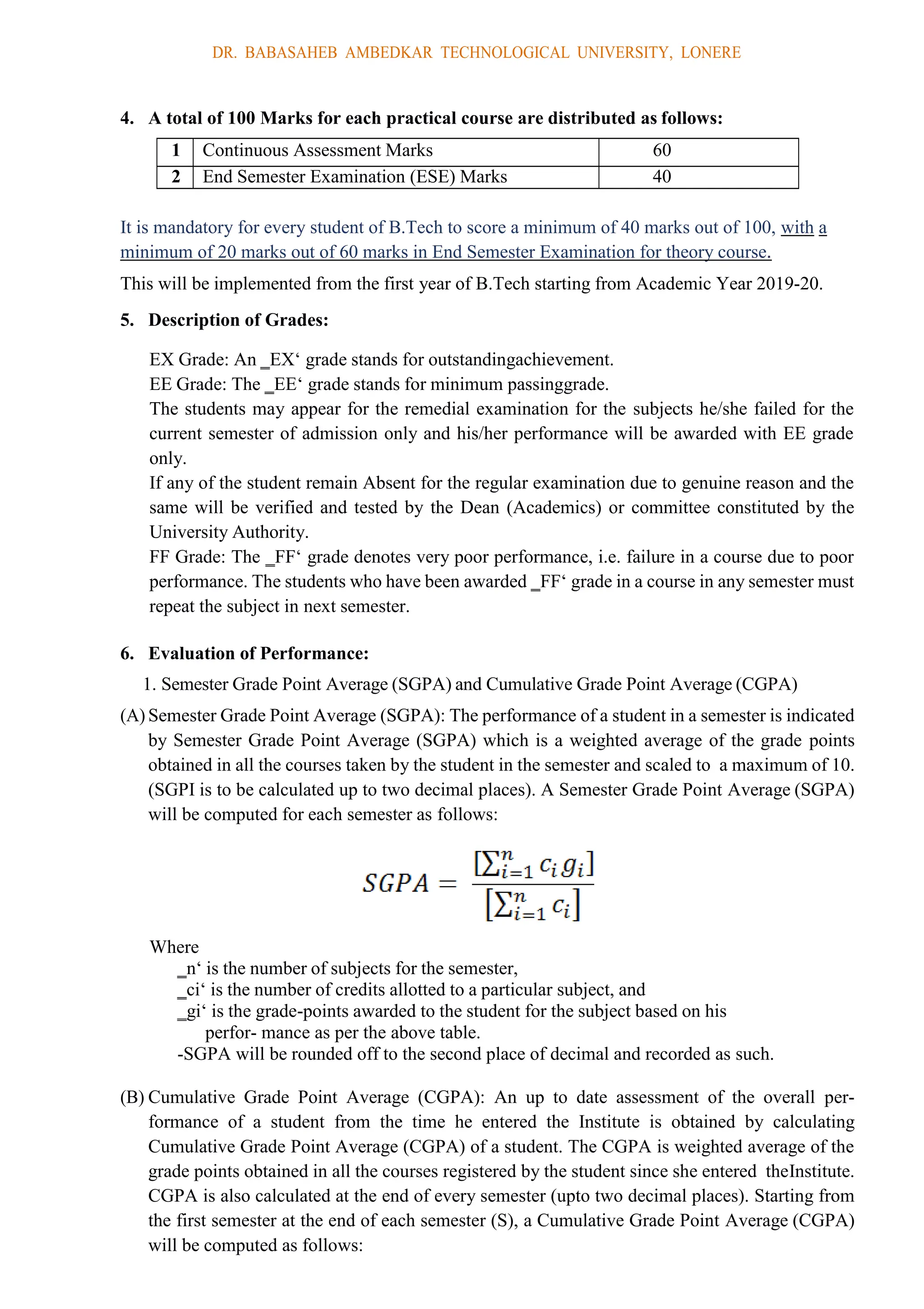
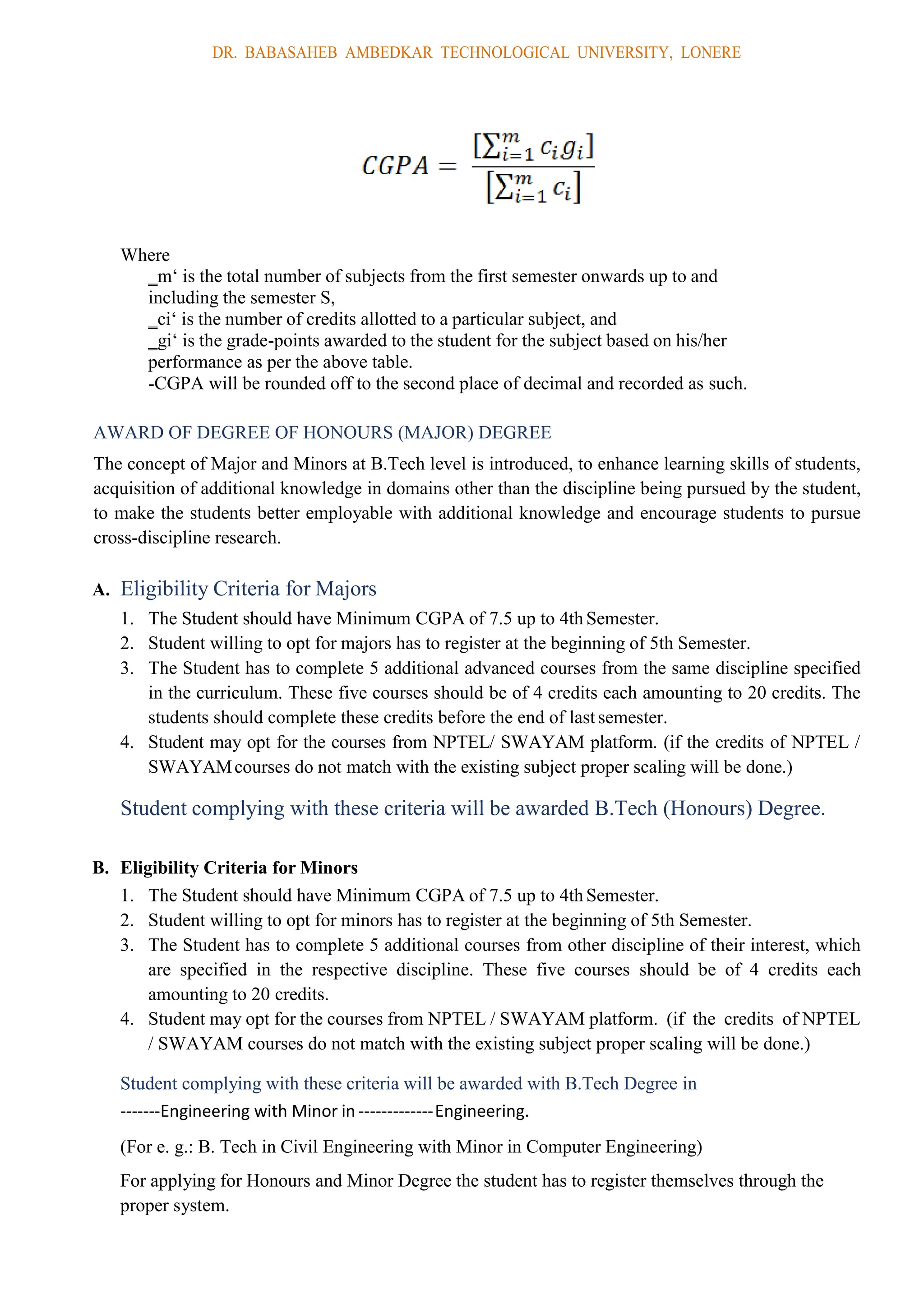

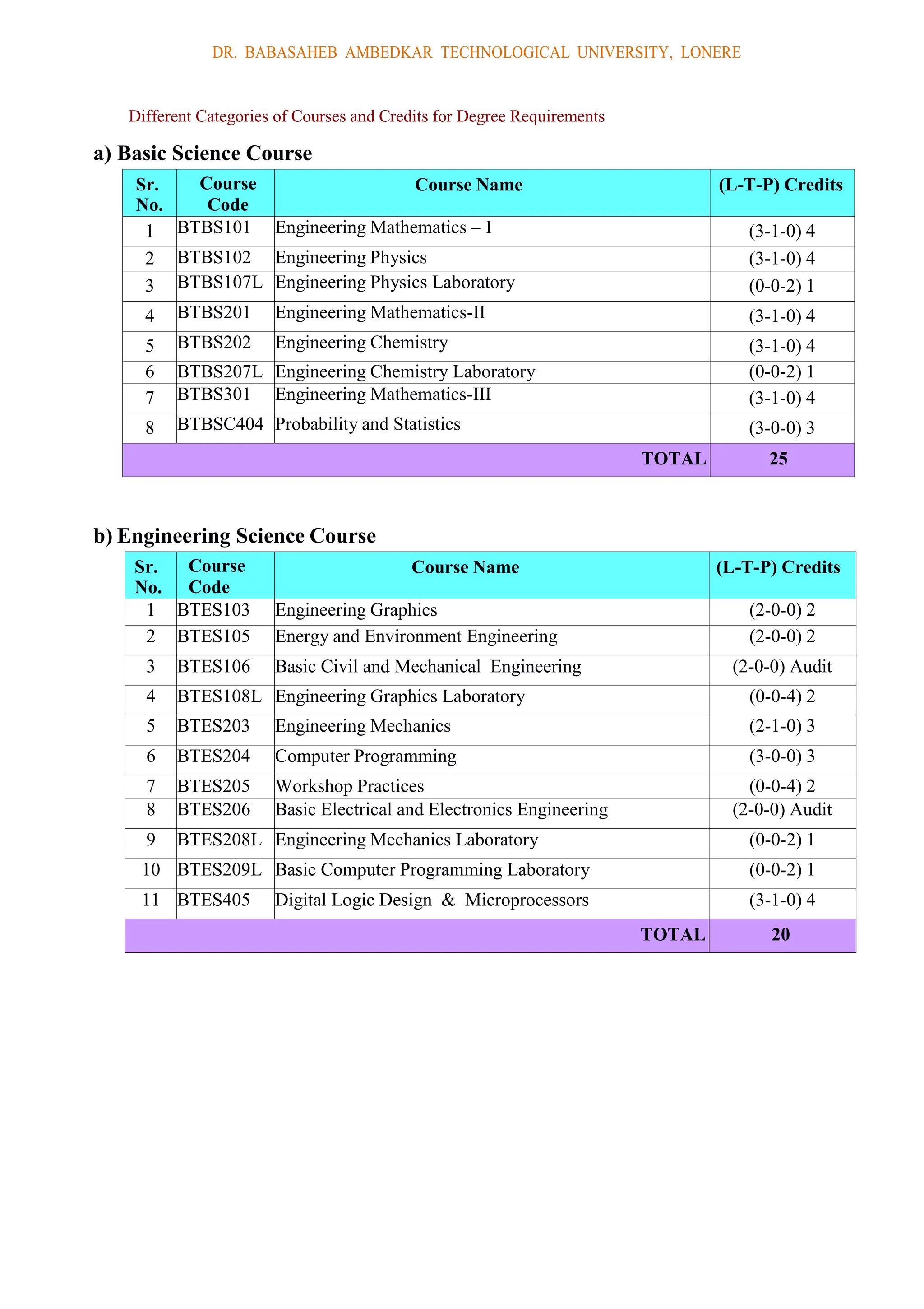
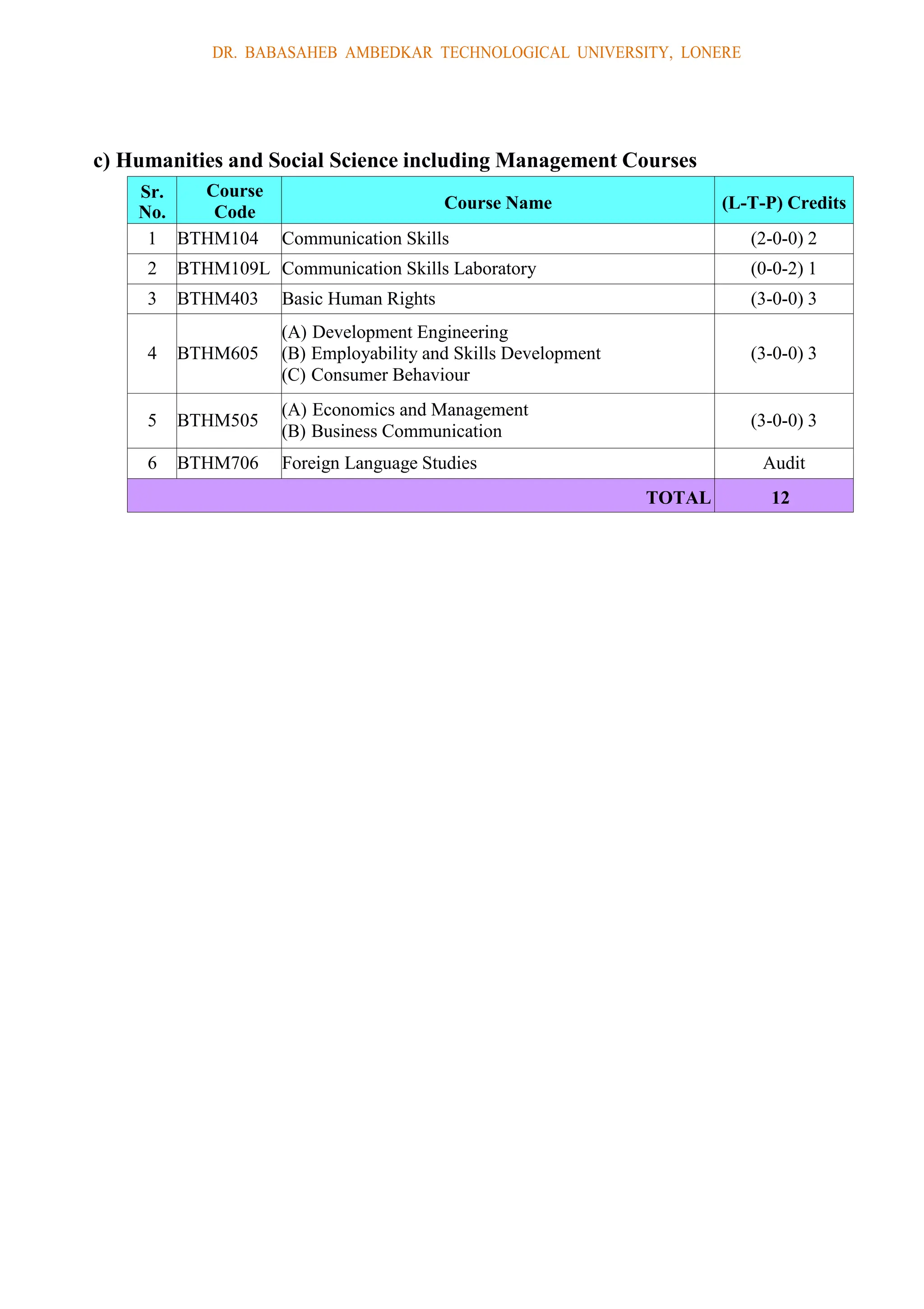

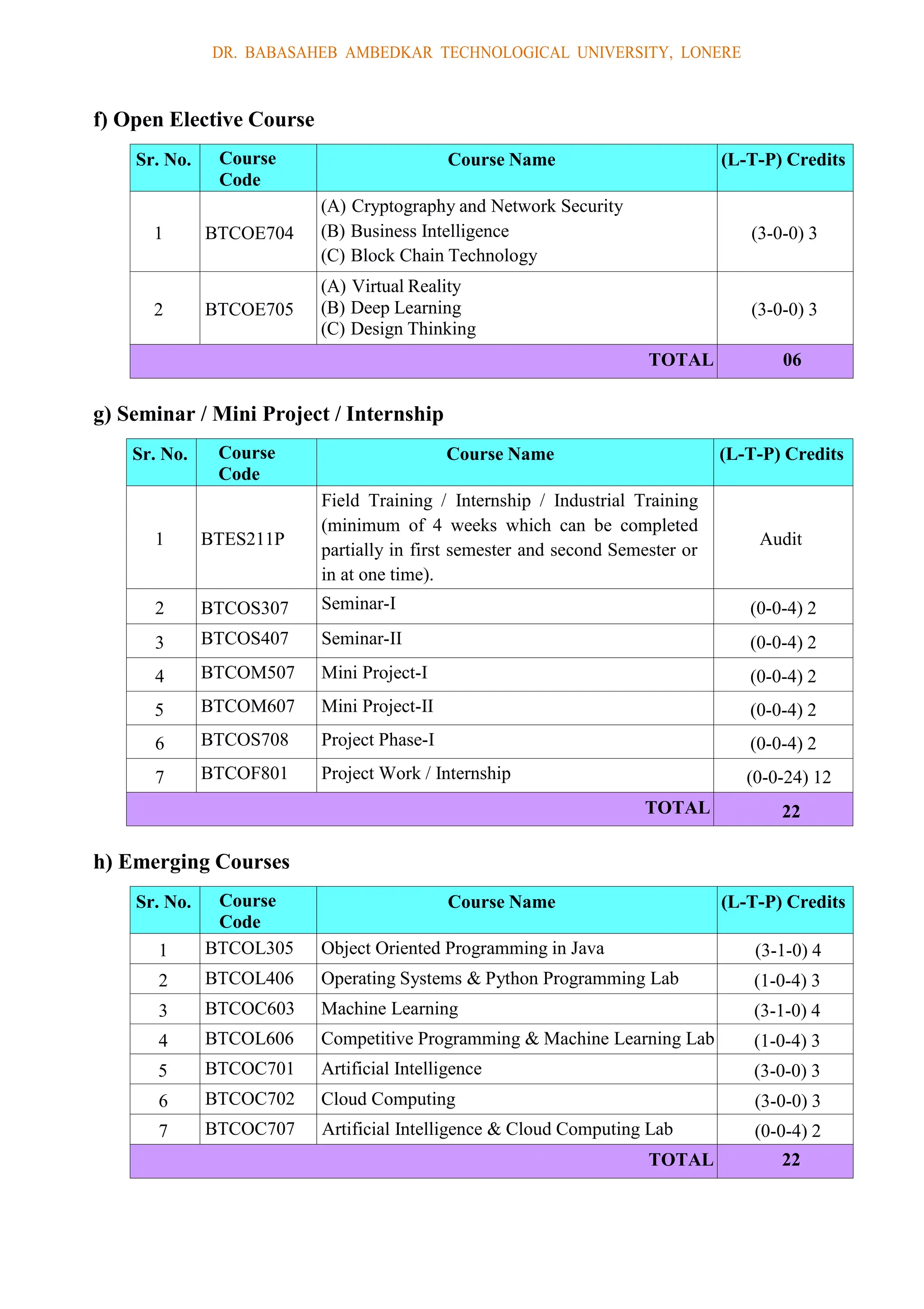
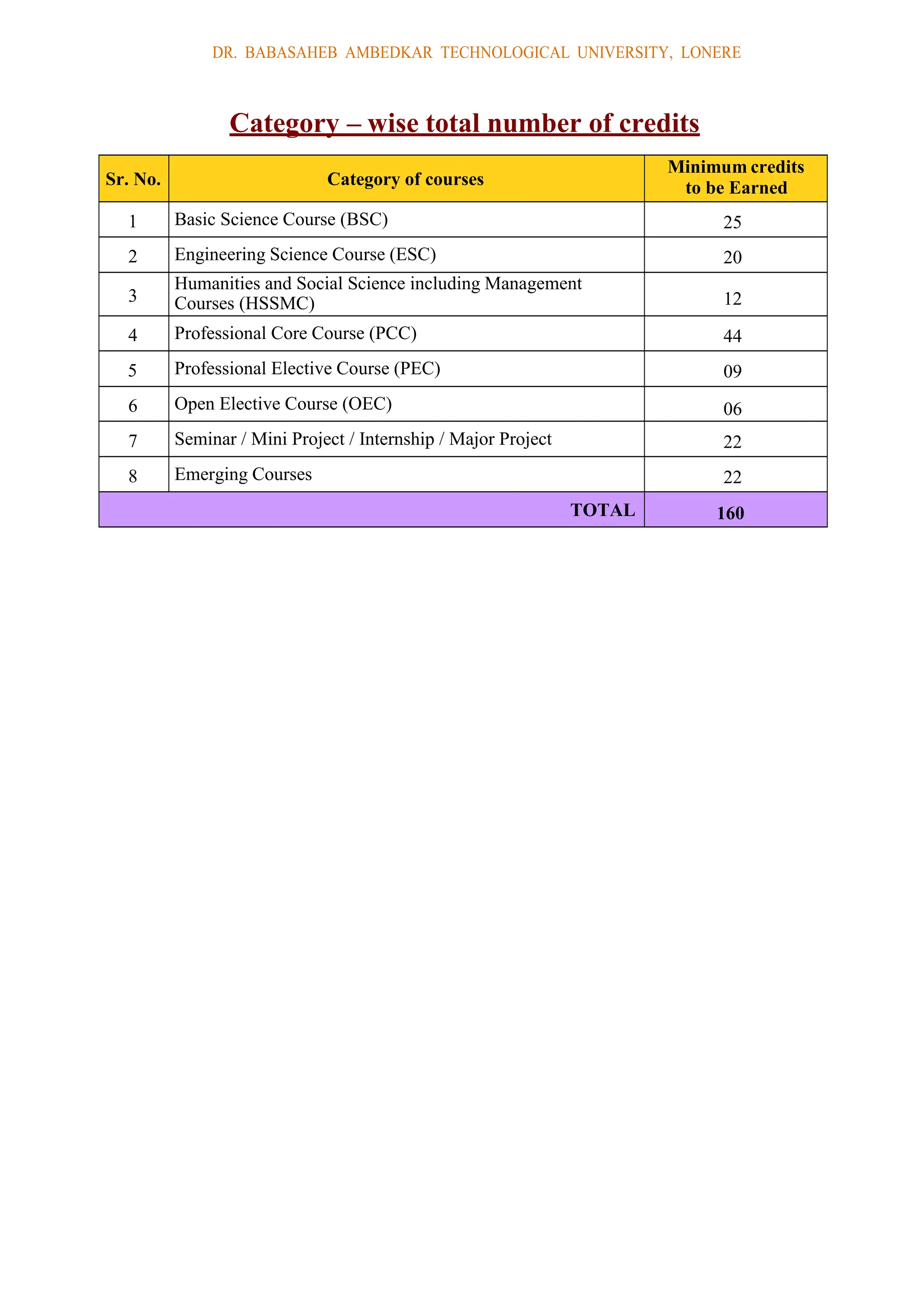

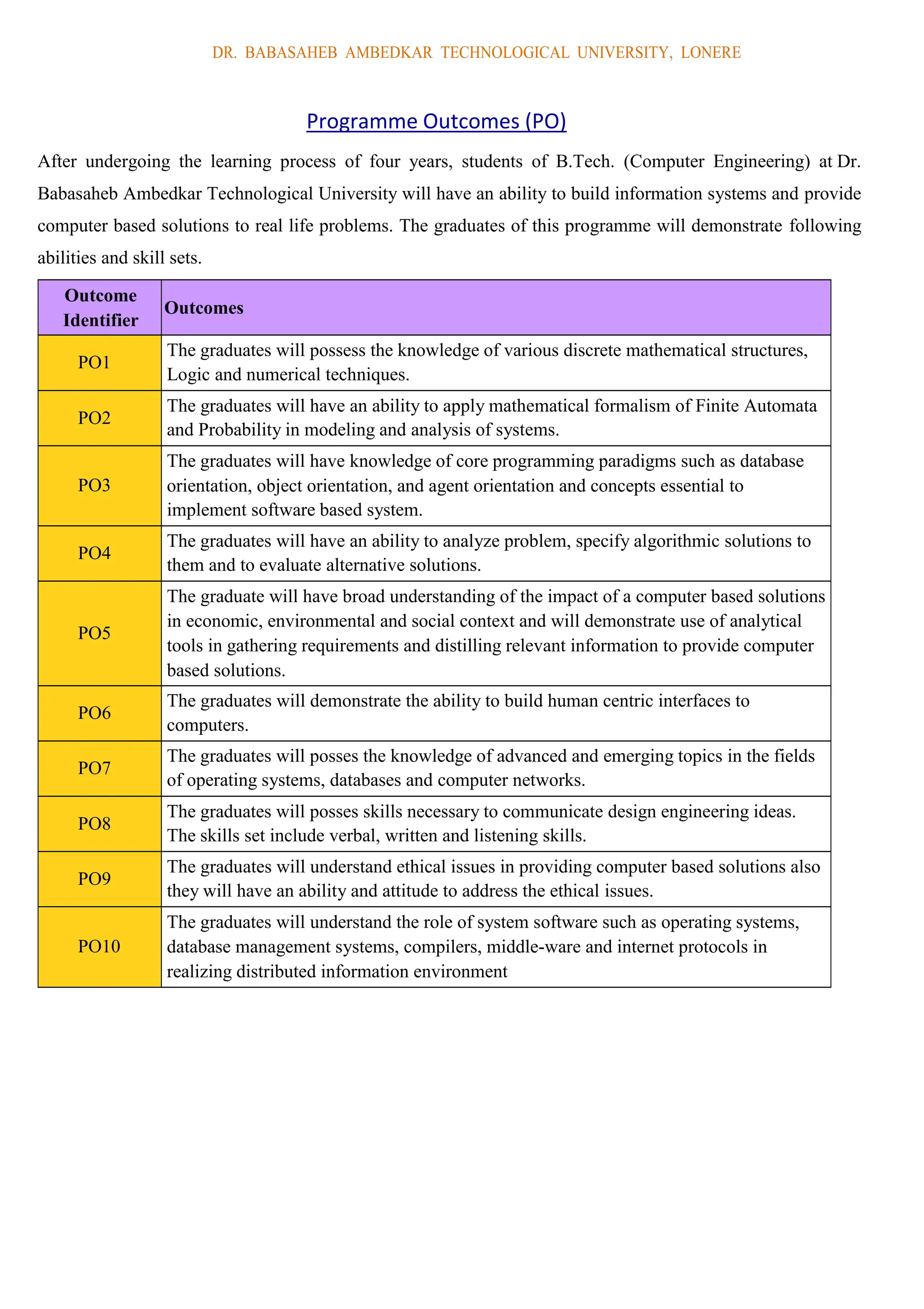

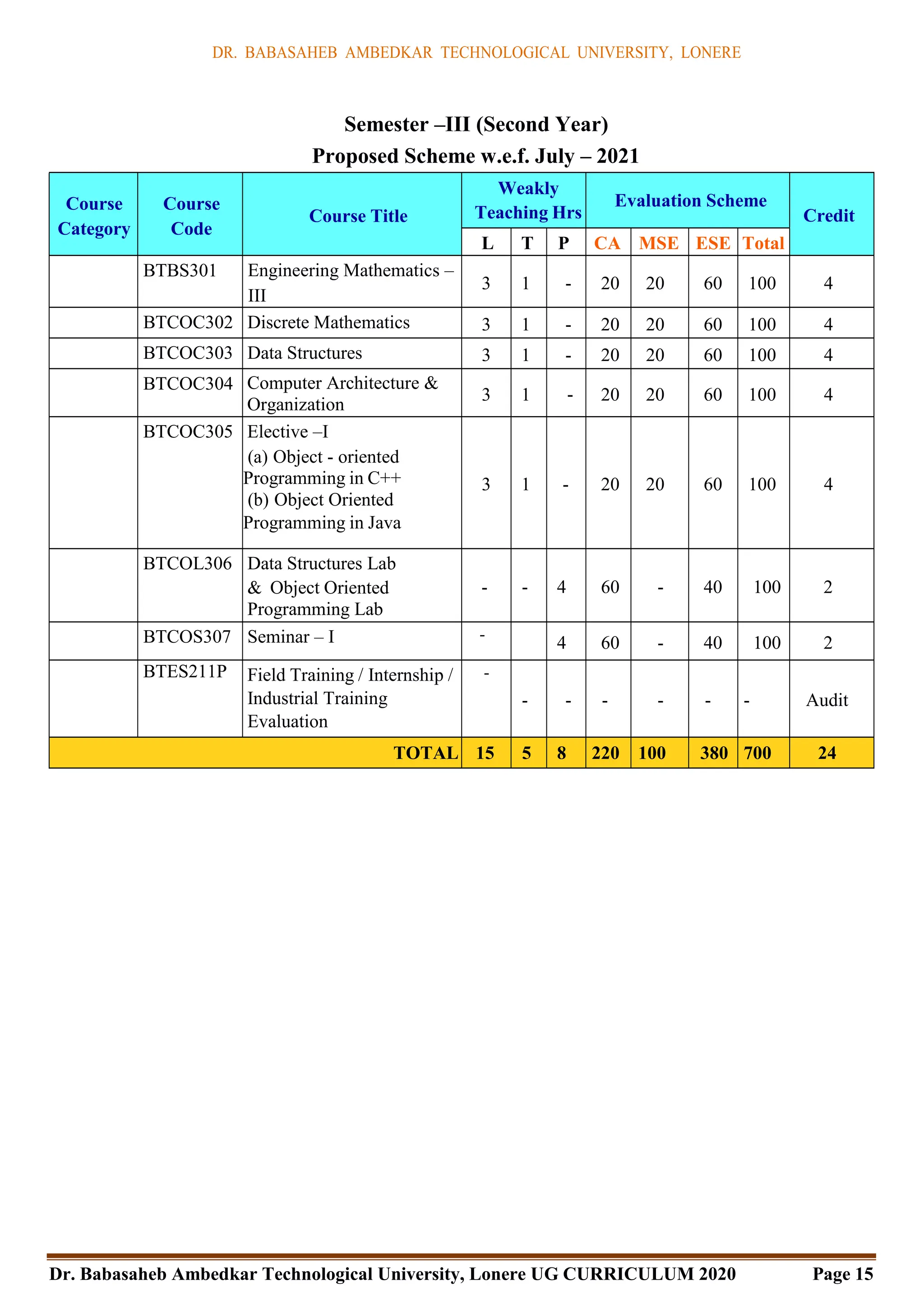
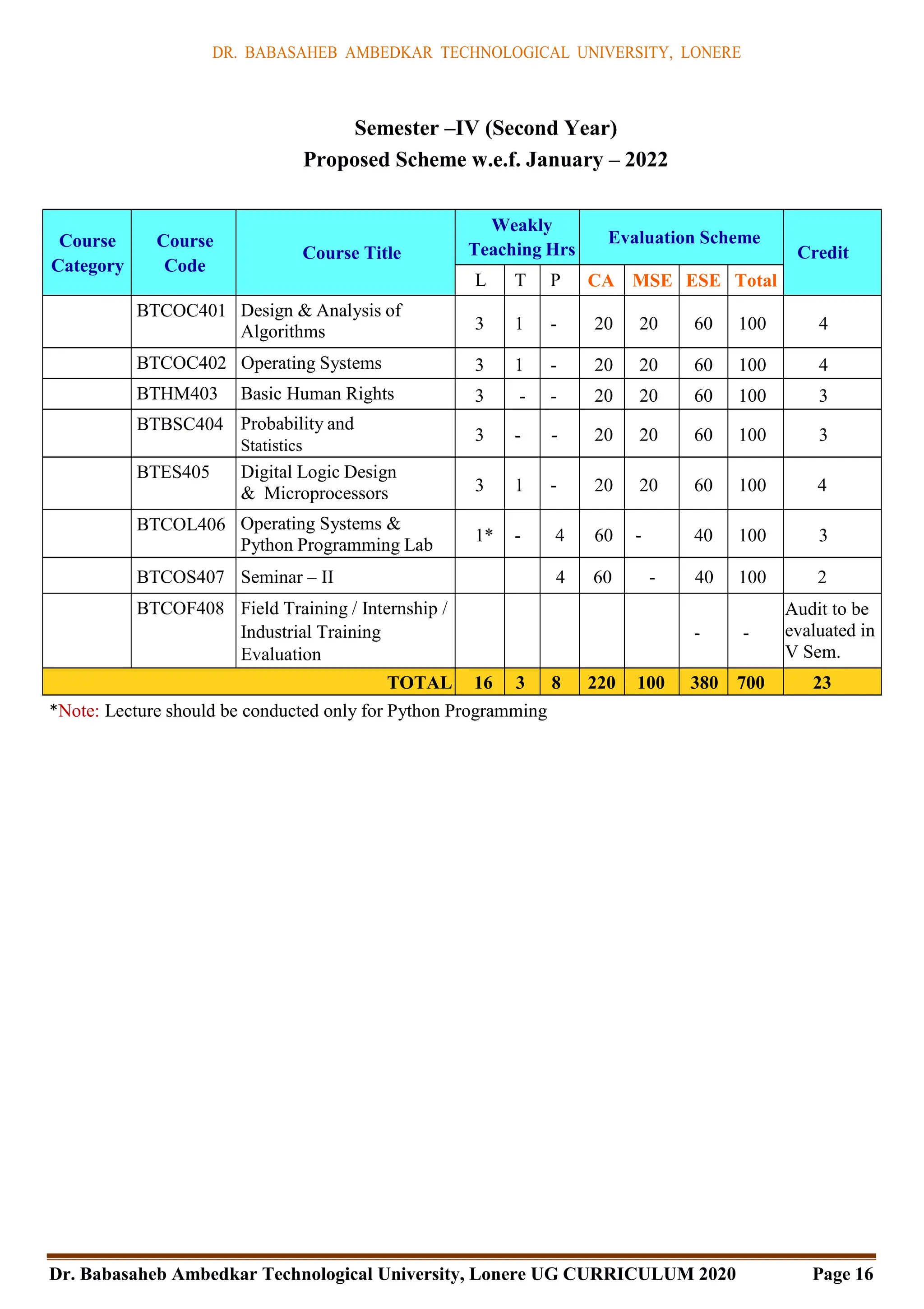
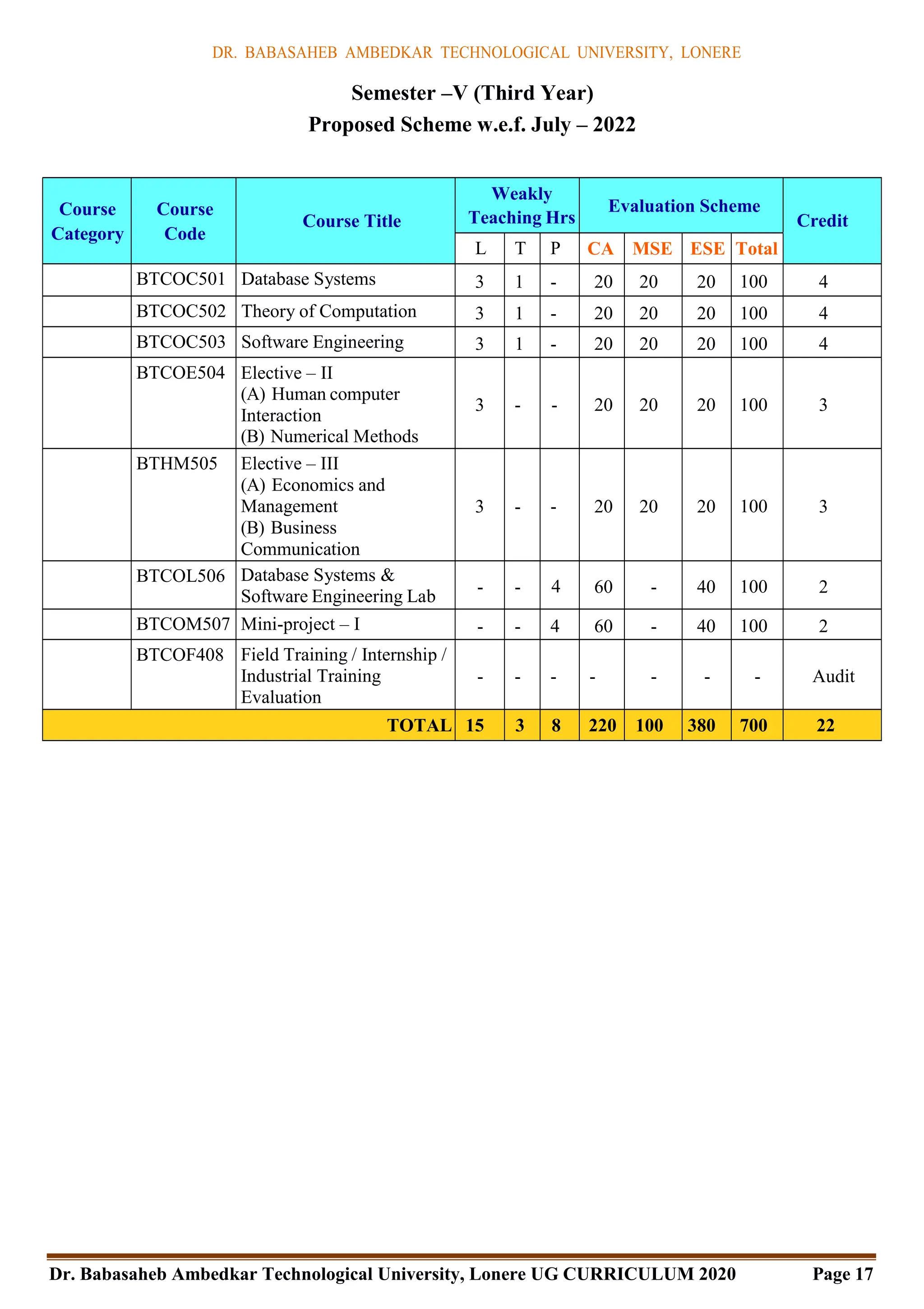


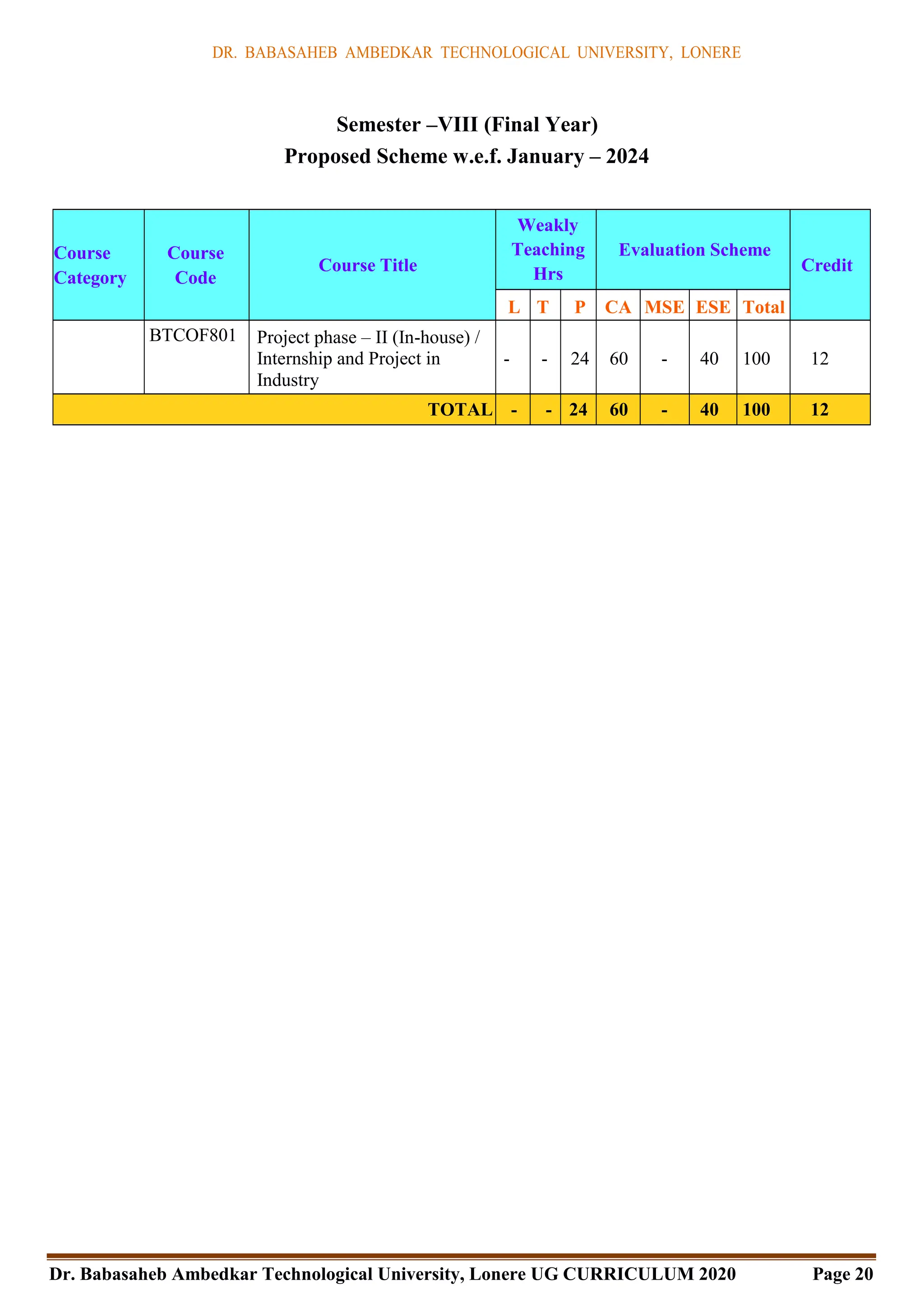
![DR. BABASAHEB AMBEDKAR TECHNOLOGICAL UNIVERSITY, LONERE
Dr. Babasaheb Ambedkar Technological University, Lonere UG CURRICULUM 2020 Page 21
BTBS 301: Engineering Mathematics-III
Subject: Engineering Mathematics III (BTBS 301) Semester: III
Teaching Scheme Examination Scheme
Theory: 03 Hrs./Week Mid-term Test : 20 Marks
Tutorial: 01 Hr./Week Internal Assessment: 20 Marks
Credits: 04 End Semester Exam: 60 Marks
Duration: 03 Hrs.
Unit 1: Laplace Transform [09 Hours]
Definition – conditions for existence ; Transforms of elementary functions ; Properties of Laplace transforms -
Linearity property, first shifting property, second shifting property, transforms of functions multiplied by tn
, scale
change property, transforms of functions divided by t, transforms of integral of functions, transforms of derivatives
; Evaluation of integrals by using Laplace transform; Transforms of some special functions- periodic function,
Heaviside-unit step function, Dirac delta function.
Unit 2: Inverse Laplace Transform [09 Hours]
Introductory remarks ; Inverse transforms of some elementary functions ; General methods of finding inverse
transforms ; Partial fraction method and Convolution Theorem for finding inverse Laplace transforms ;
Applications to find the solutions of linear differential equations and simultaneous linear differential equations
with constant coefficients.
Unit 3: Fourier Transform [09 Hours]
Definitions – integral transforms ; Fourier integral theorem (without proof) ; Fourier sine and cosine integrals
;Complex form of Fourier integrals ; Fourier sine and cosine transforms; Properties of Fourier transforms ;
Parseval’s identity for Fourier Transforms.
Unit 4: Partial Differential Equations and Their Applications [09 Hours]
Formation of Partial differential equations by eliminating arbitrary constants and functions; Equations solvable by
direct integration; Linear equations of first order (Lagrange’s linear equations); Method of separation of variables
– applications to find solutions of one dimensional heat flow equation
𝜕𝑢
𝜕𝑡
= 𝐶2 𝜕2𝑢
𝜕𝑥2
and one dimensional wave
equation (i.e.
𝜕2𝑦
𝜕𝑡2
= 𝐶2 𝜕2𝑦
𝜕𝑥2
).
Unit 5: Functions of Complex Variables [09 Hours]
Analytic functions; Cauchy- Riemann equations in Cartesian and polar forms; Harmonic functions in Cartesian
form; Cauchy’s integral theorem; Cauchy’s integral formula; Residues; Cauchy’s residue theorem (All theorems
without proofs)
Text Books
1. Higher Engineering Mathematics by B. S. Grewal, Khanna Publishers, New Delhi.
2. Higher Engineering Mathematics by H. K. Das and Er. Rajnish Verma, S. Chand & CO. Pvt. Ltd., New Delhi.
3. A course in Engineering Mathematics (Vol III) by Dr. B. B. Singh, Synergy Knowledgeware, Mumbai.
4. Higher Engineering Mathematics by B. V. Ramana, Tata McGraw-Hill Publications, New Delhi.
Reference Books
1. Advanced Engineering Mathematics by Erwin Kreyszig, John Wiley & Sons, New York.
2. A Text Book of Engineering Mathematics by Peter O’ Neil, Thomson Asia Pte Ltd. , Singapore.
3. Advanced Engineering Mathematics by C. R. Wylie & L. C. Barrett, Tata Mcgraw-Hill Publishing Company
Ltd., New Delhi.
4. Integral Transforms and their Engineering Applications by Dr. B. B. Singh, Synergy. Knowledge ware,
Mumbai.
5. Integral Transforms by I. N. Sneddon, Tata McGraw-Hill, New York.](https://image.slidesharecdn.com/dbatusyllabus-240425025908-3b234bc1/75/Dbatu-syllabus-basic-human-rights-of-SY-computer-science-engineering-of-DBATU-21-2048.jpg)
![DR. BABASAHEB AMBEDKAR TECHNOLOGICAL UNIVERSITY, LONERE
Dr. Babasaheb Ambedkar Technological University, Lonere UG CURRICULUM 2020 Page 22
BTCOC302: Discrete Mathematics
[UNIT 1] Fundamental Structures and Basic Logic [7 Hours]
Sets, Venn diagram, Cartesian product, Power sets, Cardinality and countability, Propositional logic, Logical
connectives, Truth tables, Normal forms, Validity, Predicate logic, Limitations of predicate logic, Universal and
existential quantification, First order logic, Principles of Mathematical Induction: The Well-Ordering Principle,
Recursive definition, The Division algorithm: Prime Numbers, The Greatest Common Divisor: Euclidean
Algorithm, The Fundamental Theorem of Arithmetic.
[UNIT 2] Functions and Relations [7 Hours]
Subjective, Injective, Bijective and inverse functions, Composition of function, Reflexivity, Symmetry,
Transitivity and equivalence relations.
Combinatorics: Counting, Recurrence relations, generating functions.
[UNIT 3] Graph [7 Hours]
Basic terminology, Multi graphs and weighted graphs, Paths and circuits, Shortest path problems, Euler and
Hamiltonian paths, Representation of graph, Isomorphic graphs, Planar graphs, Connectivity, Matching
Colouring.
[UNIT 4] Trees [7 Hours]
Trees: Rooted trees, Path length in rooted tree, Binary search trees, Spanning trees and cut set, Minimal
spanning trees, Kruskal‘s and Prim‘s algorithms for minimal spanning tree.
[UNIT 5] Algebraic Structures and Morphism [7 Hours]
Algebraic Structures with one Binary Operation, Semi Groups, Monoids, Groups, Congruence Relation and
Quotient Structures, Free and Cyclic Monoids and Groups, Permutation Groups, Substructures, Normal
Subgroups, Algebraic Structures with two Binary Operation, Rings, Integral Domain and Fields, Boolean
Algebra and Boolean Ring, Identities of Boolean Algebra, Duality, Representation of Boolean Function,
Disjunctive and Conjunctive Normal Form.
Text Books:
1. C. L. Liu, Elements of Discrete Mathematics, McGraw-Hill Publication, 3rd Edition, 2008.
Reference Books:
1. Lipschutz, Discrete Mathematics, McGraw-Hill Publication, 3rd Edition, 2009.
2. V. K. Balakrishnan, Schaum's Outline of Graph Theory, McGraw-Hill Publication, 1st Edition,
1997.
3. Eric Gossett, Discrete Mathematics with Proof, Wiley Publication, 2nd Edition, 2009.
4. Kenneth H. Rosen, Discrete Mathematics and its Applications, McGraw-Hill Publication, 6th
Edition, 2010.Y. N. Singh, Discrete Mathematical Structures, Wiley Publication, 1st Edition, 2010.
5. Dr. Sukhendu Dey, Graph Theory with Applications, SPD Publication, 1st Edition, 2012.](https://image.slidesharecdn.com/dbatusyllabus-240425025908-3b234bc1/75/Dbatu-syllabus-basic-human-rights-of-SY-computer-science-engineering-of-DBATU-22-2048.jpg)
![DR. BABASAHEB AMBEDKAR TECHNOLOGICAL UNIVERSITY, LONERE
Dr. Babasaheb Ambedkar Technological University, Lonere UG CURRICULUM 2020 Page 23
BTCOC303: Data Structures
[UNIT 1] Introduction [7 Hours]
Data, Data types, Data structure, Abstract Data Type (ADT), representation of Information, characteristics of
algorithm, program, analyzing programs. Arrays and Hash Tables Concept of sequential organization, linear
and non-linear data structure, storage representation, array processing sparse matrices, transpose of sparse
matrices, Hash Tables, Direct address tables, Hash tables, Hash functions, Open addressing, Perfect hashing.
[UNIT 2] Stacks and Queues [7 Hours]
Introduction, stack and queue as ADT, representation and implementation of stack and queue using sequential
and linked allocation, Circular queue and its implementation, Application of stack for expression evaluation
and expression conversion, recursion, priority queue.
[UNIT 3] Linked list [7 Hours]
Concept of linked organization, singly and doubly linked list and dynamic storage management, circular
linked list, operations such as insertion, deletion, concatenation, traversal of linked list, dynamic memory
management, garbage collection.
[UNIT 4] Trees and Graphs [7 Hours]
Basic terminology, binary trees and its representation, insertion and deletion of nodes in binary tree, binary
search tree and its traversal, threaded binary tree, Heap, Balanced Trees, Terminology and representation of
graphs using adjacency matrix, Warshall‘s algorithm.
[UNIT 5] Searching and Sorting [7 Hours]
Sequential, binary searching, skip lists – dictionaries, linear list representation, skip list representation,
operations– insertion, deletion and searching. Insertion sort, selection sort, radix sort, File handling.
Text Book:
1. Weiss, Data structures and algorithms analysis in C++, Pearson Education, 4th Edition,2013
Reference Books:
1. S. Lipschutz, Data Structures, McGraw-Hill Publication, Revised 1st Edition, 2014.
2. Y.Langsm, M. Augenstin, A. Tanenbaum , Data Structure using C and C++, Prentice Hall India
Learning Private Limited,2nd
edition,1998.
3. Horowitz and Sahani, Fundamentals of Data Structures, Universities Press, 2nd Edition,2008.
4. Thomas Cormen, Introduction to Algorithms, PHI Publication, 2nd Edition,2002.
5. Venkatesan& Rose, Data Structures, Wiley Publication, 1st Edition,2015.
6. Goodrich &Tamassia, Data Structure & Algorithm in C++, Wiley Publication, 2nd Edition,2011.
7. R. G. Dromey, How to Solve it by Computer, 2nd Impression, PearsonEducation.
8. Kyle Loudon, Mastering Algorithms with C: Useful Techniques from Sorting to Encryption,
O'Reilly Media, 1st Edition,1999.](https://image.slidesharecdn.com/dbatusyllabus-240425025908-3b234bc1/75/Dbatu-syllabus-basic-human-rights-of-SY-computer-science-engineering-of-DBATU-23-2048.jpg)
![DR. BABASAHEB AMBEDKAR TECHNOLOGICAL UNIVERSITY, LONERE
Dr. Babasaheb Ambedkar Technological University, Lonere UG CURRICULUM 2020 Page 24
BTCOC 304: Computer Architecture and Organization
[UNIT 1] Introduction [7 Hours]
Concept of computer organization and architecture, Fundamental unit, Computer function and interconnection,
CPU structure and function
[Unit 2] Instruction Sets [7 Hours]
Characteristics, Types of operands, Types of operations, Assembly language, Addressing modes, Instruction
format, Types of instruction, Instruction execution, Machine state and processor status, Structure of program,
Introduction to RISC and CISC architecture.
[Unit 3] Computer Arithmetic [7 Hours]
The arithmetic and logic Unit, Integer representation, Integer arithmetic, Floating point representation, Floating
point arithmetic, Introduction of arithmetic co-processor.
[Unit 4] Memory Organization [7 Hours]
Internal Memory: Semiconductor main memory, Error correction, Advanced DRAM organization, Virtual
memory systems and cache memory systems. External Memory: Organization and characteristics of magnetic
disk, Magnetic tape, Optical memory, RAID, Memory controllers.
[Unit 5] Control Unit and Input / Output Organization [7 Hours]
Control unit operation: Micro-operations, Control of the processor, Hardwired implementation, Micro-
programmed Control Unit, Basic concepts, Micro-instruction sequencing, Micro-instruction execution,
Applications of micro-programming. Input/output Organization: External devices, I/O module, Programmed
I/O, Interrupt driven I/O, Direct memory access, I/O channels and processors, External interface.Instruction
pipe-lining: Concepts. Parallel processing: Multiple processor organization, Symmetric multiprocessor, Cache
coherence and the MESI protocol.
Text Book:
1. William Stalling, Computer Organization and Architecture: Designing for Performance, Prentice
Hall Publication, 8th Edition, 2009.
Reference Books:
1. Hayes, Computer Architecture and Organization, McGraw-Hill Publication, 3rd Edition, 2012.
2. Zaky, Computer Organization, McGraw-Hill Publication, 5th Edition, 2011.
3. Hennessy and Patterson, Computer Architecture: A Quantitative Approach, Morgan and Kaufman
Publication, 4th Edition, 2007.
4. Morris Mano, Computer System Architecture, Pearson Education India, 3rd Edition,2007.
5. Mostafa Abd-El-Barr, Hesham El-Rewini, Fundamentals of Computer Organization and
Architecture, Wiley Publication, 1st Edition, 2004.
6. Miles J. Murdocca, Vincent P.Heuring, Computer Architecture and Organization: An Integrated
Approach, Wiley Publication, 1st Edition, 2007.
7. Sajjan G. Shiva, Computer Organization: Design, and Architecture, CRC Press, 5th Edition,
2013.](https://image.slidesharecdn.com/dbatusyllabus-240425025908-3b234bc1/75/Dbatu-syllabus-basic-human-rights-of-SY-computer-science-engineering-of-DBATU-24-2048.jpg)
![DR. BABASAHEB AMBEDKAR TECHNOLOGICAL UNIVERSITY, LONERE
Dr. Babasaheb Ambedkar Technological University, Lonere UG CURRICULUM 2020 Page 25
Elective –I
(A) BTCOC 305: Object Oriented Programming in C++
[Unit 1] Introduction to Object Oriented Programming and Objects and Classes [7 Hours]
Need of object oriented programming, The object oriented approach, Characteristics of object oriented
languages, class, Objects as data types, Constructors, Objects as function arguments, Returning objects.
[Unit 2] Operator Overloading, Inheritance and Polymorphism [7 Hours]
Overloading unary and binary operators, Data conversion. Derived and base class, Public and private
inheritance, Levels of inheritance, multiple inheritance Examples.
[Unit 3] Polymorphism [7 Hours]
Virtual functions, Dynamic binding, Abstract classes and pure virtual functions, Friend functions, this pointer.
[Unit 4] Streams and Files [7 Hours]
Streams, Stream output and input, Stream manipulators, Files and streams, Creating, Reading, Updating
sequential and random files.
[Unit 5] Templates, Exception Handling and STL [7 Hours]
Function templates, Overloading function templates, Class templates, Exception handling overview, Need of
exceptions, An exception example, Multiple exceptions, Exception specifications. Standard Template Library
(STL) Introduction to STL-Containers, Iterators, Algorithms, Sequence containers, Associative containers,
Container adapters.
Text Book:
1. E. Balagurusamy, Object Oriented Programming with C++, McGraw-Hill Publication, 6th
Edition, 2013.
Reference Books:
1. Robert Lafore, Object Oriented Programming in C++, Sams Publishing, 4th Edition, 2001.
2. Dr. B. B. Meshram, Object Oriented Paradigms with C++ Beginners Guide for C and C++, SPD
Publication, 1st Edition, 2016.
3. Rajesh R. Shukla, Object-Oriented Programming in C++, Wiley India Publication, 1st
Editio,2008
4. Bjarne Stroustrup, The C++ Programming Language, Addison-Wesley Publication, 4th Edition,
2013.
5. P.J. Deitel, H. M. Deitel, C++ How to Program, PHI Publication, 9th Edition, 2012.
6. John Hubbard, Programming with C++, Schaum‘s Outlines, McGraw-Hill Publication, 2nd
Edition, 2000.
7. Nicolai M. Josuttis, Object-Oriented Programming in C++, Wiley Publication, 1st Edition, 2002.](https://image.slidesharecdn.com/dbatusyllabus-240425025908-3b234bc1/75/Dbatu-syllabus-basic-human-rights-of-SY-computer-science-engineering-of-DBATU-25-2048.jpg)
![DR. BABASAHEB AMBEDKAR TECHNOLOGICAL UNIVERSITY, LONERE
Dr. Babasaheb Ambedkar Technological University, Lonere UG CURRICULUM 2020 Page 26
Elective –I
(B) BTCOC 305: Object Oriented Programming in JAVA
[Unit 1] Introduction to Java Applications [7 Hours]
Introduction, Java Class Libraries, Typical Java Development Environment, Memory Concepts, Arithmetic.
Introduction to Classes and Objects: Introduction, Classes, Objects, Methods and Instance Variables, Declaring
a Class witha Method and Instantiating an Object of a Class, Declaring a Method, Instance variables, set
Methods and get Methods, Primitive Types vs. Reference type double Types ,Initializing Objects with
Constructors, floating point numbers.
[Unit 2] Control Statements [7 Hours]
Control structures if single-selection statement, if….else double-selection statement, while repetition statement,
do….while repetition statement, switch multi-selection statement, break and continue statements, logical
operators. Methods :Introduction, Program modules in Java, static methods, static Fields and Class Math,
declaring methods with multiple parameters, scope of declaration, method overloading and Java API packages.
[Unit3]Arrays [7 Hours]
Arrays,declaring and creating arrays in java, examples using arrays, passing arrays to methods,
multidimensional arrays, variable-length argument lists, using command-line arguments.
[Unit 4] Inheritance and Polymorphism in Java [7 Hours]
Inheritance: Super classes and Subclasses, protected members, relationship between super classes and
subclasses, constructors in subclasses, objectclass. Polymorphism: Abstract classes and methods, final methods
and classes, polymorphism examples and Interfaces.
[Unit 5] Exception-handling and Java script [7 Hours]
Exception-handling overview, handling Arithmetic Exceptions and Input Mismatch Exceptions, when to use
exception handling, java exception hierarchy, finally block. Introduction to Java Applets. Java script:
Introduction to client side scripting, Syntax basics, Operators, Comparisons, Statements, Loops, Events,
Objects, and User defined functions, Validations using object functions, Validations using regular expressions,
JS document object model, popovers, windows
Text Book:
1. Paul Deitel and Harvey Detail, Java: How to Program, Pearson's Publication, 9thEdition.
Reference Books:
1. Joel Murach and Michael Urban, Murach’s Beginning Java with Eclipse, Murach's
Publication, 1st Edition, 2016. Doug Lowe, Java All-in-One For Dummies, Wiley
Publication, 4th Edition,2014.
2. Herbert Schildt, Java The Complete Reference, McGraw-Hill Publication, 9thEdition.
3. Patrick Niemeyer, Daniel Leuck, Learning Java, O'Reilly Media, 4th Edition,2013.
4. ―JavaScript: The Good Parts‖, Douglas Crockford, O‘Reilly, ISBN: 9782744055973.
―Microsoft® .NET: Architecting Applications for the Enterprise‖, Microsoft Press; 1st
edition, ISBN:978-0735626096](https://image.slidesharecdn.com/dbatusyllabus-240425025908-3b234bc1/75/Dbatu-syllabus-basic-human-rights-of-SY-computer-science-engineering-of-DBATU-26-2048.jpg)
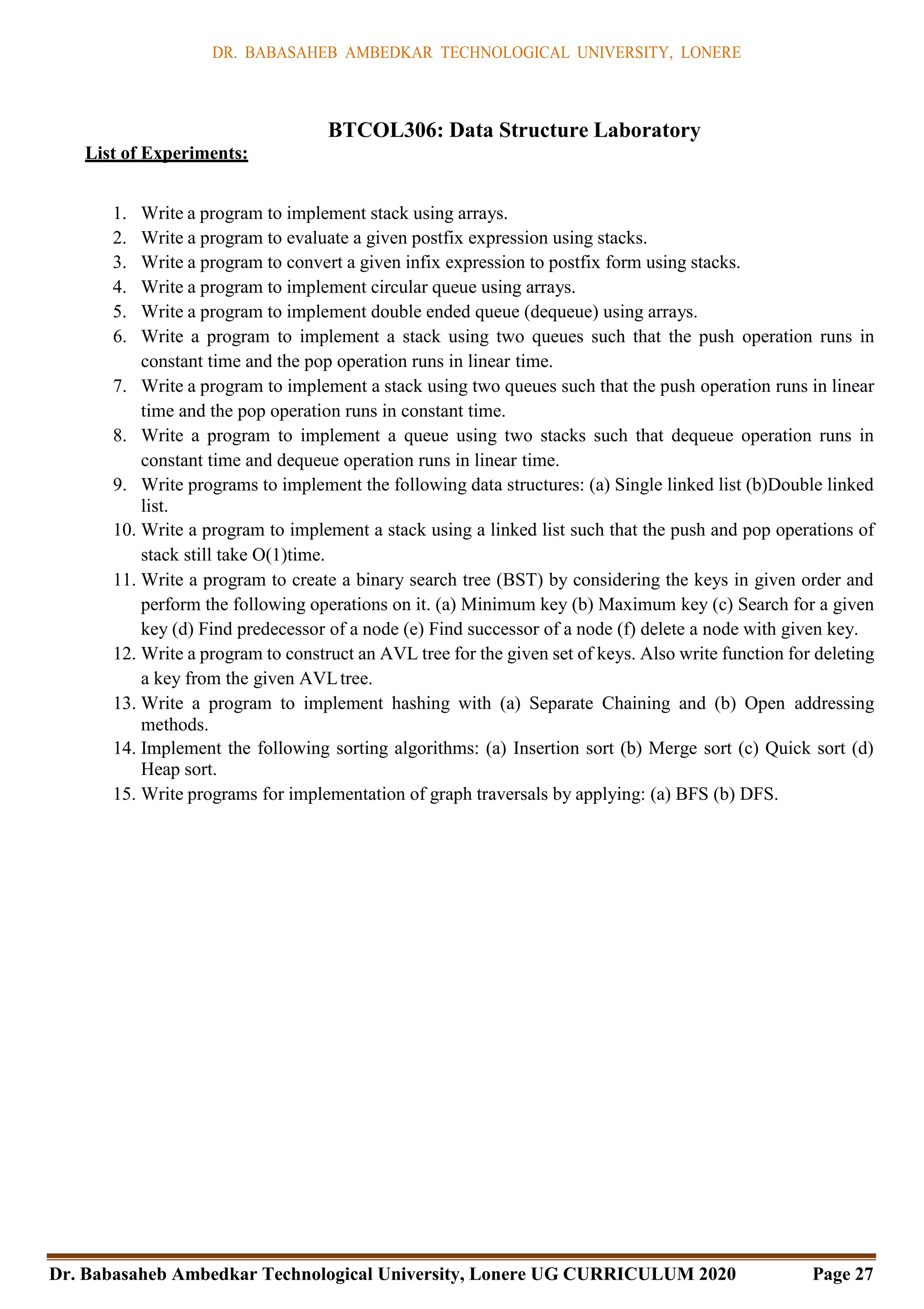

![DR. BABASAHEB AMBEDKAR TECHNOLOGICAL UNIVERSITY, LONERE
Dr. Babasaheb Ambedkar Technological University, Lonere UG CURRICULUM 2020 Page 29
BTCOC401: Design and Analysis of Algorithms
[Unit 1] Introduction to Algorithms [7 Hours]
Definition, Properties of Algorithms, Expressing Algorithm, Flowchart, Algorithm Design Techniques,
Performance Analysis of Algorithms, Types of Algorithm's Analysis, Order of Growth, Asymptotic Notations,
Recursion, Recurrences Relation, Substitution Method, Iterative Method, Recursion Tree, Master Theorem,
Changing Variable, Heap Sort.
[Unit 2] Divide and Conquer [7 Hours]
Introduction, Binary Search, Merge Sort, Quick Sort, Strassen‘s Matrix Multiplication.
[Unit 3] Backtracking [7 Hours]
Backtracking Concept, N–Queens Problem, Four–Queens Problem, Eight–Queen Problem, Hamiltonian Cycle,
Sum of Subsets Problem, Graph Colouring Problem, Branch and Bound: Introduction, Travelling Salesperson
Problem, 15-Puzzle Problem, Comparisons between Backtracking and Branch and Bound.
[Unit 4] Greedy Algorithms [7 Hours]
Introduction to Greedy Technique, Greedy Method, Optimal Merge Patterns, Huffman Coding, Knapsack
Problem, Activity Selection Problem, Job Sequencing with Deadline, Minimum Spanning Tree, Single-Source
Shortest Path Algorithm
.
[Unit 5] Dynamic Programming [7 Hours]
Introduction, Characteristics of Dynamic Programming, Component of Dynamic Programming, Comparison
of Divide-and-Conquer and Dynamic Programming Techniques, Longest Common Sub-sequence, matrix
multiplication, shortest paths: Bellman Ford, Floyd Warshall, Application of Dynamic Programming. NP
Completeness: Introduction, the Complexity Class P, the Complexity Class NP, Polynomial-Time Reduction,
the Complexity Class NP-Complete.
Text Book:
1. T. Cormen, Introduction to Algorithms, PHI Publication, 2nd Edition, 2002.
Reference Books:
1. Aho, Ullman, Data Structure and Algorithms, Addison-Wesley Publication, 1st Edition,1983.
2. Michel Goodrich, Roberto Tamassia, Algorithm Design – Foundation, Analysis & Internet
Examples, Wiley Publication, 2nd Edition,2006.
3. George T. Heineman, Gary Pollice, Stanley Selkow, Algorithms in a Nutshell, A Practical Guide,
O'Reilly Media, 2nd Edition, 2016.
4. Ellise Horowitz, SartajSahni, S. Rajasekaran, Fundamentals of Computer Algorithms, University
Press (India) Private Ltd, 2nd Edition, 2008.
5. Sara Base, Computer algorithms: Introduction to Design and Analysis, Addison-Wesley
Publication, 2nd Edition, 1988](https://image.slidesharecdn.com/dbatusyllabus-240425025908-3b234bc1/75/Dbatu-syllabus-basic-human-rights-of-SY-computer-science-engineering-of-DBATU-29-2048.jpg)
![DR. BABASAHEB AMBEDKAR TECHNOLOGICAL UNIVERSITY, LONERE
Dr. Babasaheb Ambedkar Technological University, Lonere UG CURRICULUM 2020 Page 30
BTCOC402: Operating Systems
[Unit 1] [7 Hours]
Introduction and Operating system structures: Definition, Types of Operating system, Real-Time operating
system, System Components: System Services, Systems Calls, System Programs, System structure, Virtual
Machines, System Design and Implementation, System Generations.
[Unit 2] [7 Hours]
Processes and CPU Scheduling: Process Concept, Process Scheduling, Operation on process, Inter-process
Communication, Cooperating processes, Threads, Multithreading model, Scheduling criteria, Scheduling
Algorithms, Thread Scheduling, Multiple-Processor Scheduling, Scheduling Algorithms evaluation.
[Unit 3] [7 Hours]
Process Synchronization: The critical-section problem, Critical regions, Peterson‘s Solution, Synchronization
Hardware, Semaphores, Classical Problems of synchronization, and Monitors Deadlocks: Systems Model,
Deadlock characterization, Methods for handling Deadlocks, Deadlock Prevention, Deadlock Avoidance,
Deadlock Detection, Recovery from Deadlock, Combined approach to deadlock Handling.
[Unit 4] [7 Hours]
Memory Management: Basic concept, Logical and Physical address map, Memory allocation: Continuous
Memory Allocation, Fixed and variable partition, Internal and external fragmentation and compaction, Paging:
Principle of operation, Page allocation – Hardware support for paging, Protection and sharing,Disadvantages
of paging; Segmentation. Virtual Memory: Basics of Virtual Memory – Hardware and control structures –
Locality of reference, Page fault, Working Set, Dirty page / Dirty bit – Demand paging, Page Replacement
algorithms: Optimal, First in First Out (FIFO), Second Chance (SC), Not recently used (NRU) and Least
Recently used(LRU).
[Unit 5] [7 Hours]
File Management: File Concept, Access methods, File types, File operation, Directory and disk structure, File
System Structure, File System Implementation, Allocation methods (contiguous, linked, indexed), Free-space
management (bit vector, linked list, grouping), directory implementation (linear list, hash table), efficiency and
performance. Mass-Storage Structure: Disk Structure, Disk attachment, Disk scheduling, Disk management,
Swap Space Management.
Text Book:
1. Abraham Silberschatz, Peter B. Galvin and Greg Gagne, Operating System Concepts, Wiley
Publication, 8th Edition, 2008.
Reference Books:
1. Andrew S. Tanenbaum, Modern Operating System, PHI Publication, 4th Edition, 2015.
2. D. M. Dhamdhere, Systems Programming and Operating Systems, McGraw-Hill, 2nd
Edition,
1996.
3. Garry Nutt, Operating Systems Concepts, Pearson Publication, 3rd Edition, 2003.
4. Harvey M. Deitel, An Introduction to Operating Systems, Addison Wesley Publication, 2nd
Edition, 1990.
5. Thomas W.Doeppner, Operating System in Depth: Design and Programming, Wiley Publication,
2011.](https://image.slidesharecdn.com/dbatusyllabus-240425025908-3b234bc1/75/Dbatu-syllabus-basic-human-rights-of-SY-computer-science-engineering-of-DBATU-30-2048.jpg)
![DR. BABASAHEB AMBEDKAR TECHNOLOGICAL UNIVERSITY, LONERE
Dr. Babasaheb Ambedkar Technological University, Lonere UG CURRICULUM 2020 Page 31
BTHM403: Basic Human Rights
[Unit 1] [6 Hours]
The Basic Concepts: - Individual, group, civil society, state, equality, justice, Human Values, Human rights and
Human Duties: - Origin, Contribution of American bill of rights, French revolution, Declaration of
independence, Rights of citizen, Rights of working and exploited people.
[Unit 2] [6 Hours]
Fundamental rights and economic programme, Society, religion, culture, and their inter relationship, Impact
of social structure on human behavior, Social Structure and Social Problems: - Social and communal conflicts
and social harmony, rural poverty, unemployment, bonded labor.
[Unit 3] [6 Hours]
Migrant workers and human rights violations, human rights of mentally and physically challenged, State,
Individual liberty, Freedom and democracy, NGOs and human rights in India: - Land, Water, Forest issues.
[Unit 4] [6 Hours]
Human rights in Indian constitution and law:- i) The constitution of India: Preamble ii) Fundamental rights iii)
Directive principles of state policy vi)Fundamental duties v) Some other provisions.
[Unit 5] [6 Hours]
Universal declaration of human rights and provisions of India, Constitution and law, National human rights
commission and state human rights commission.
Text Book:
1. Shastry, T. S. N., India and Human rights: Reflections, Concept Publishing Company India (P
Ltd.), 2005.
Reference books:
1. Nirmal, C.J., Human Rights in India: Historical, Social and Political Perspectives (Law in
India), Oxford India](https://image.slidesharecdn.com/dbatusyllabus-240425025908-3b234bc1/75/Dbatu-syllabus-basic-human-rights-of-SY-computer-science-engineering-of-DBATU-31-2048.jpg)
![DR. BABASAHEB AMBEDKAR TECHNOLOGICAL UNIVERSITY, LONERE
Dr. Babasaheb Ambedkar Technological University, Lonere UG CURRICULUM 2020 Page 32
BTBSC404: Probability and Statistics
[Unit 1] Probability Theory [7 Hours]
Definition of probability: classical, empirical and axiomatic approach of probability, Addition theorem of
probability, Multiplication theorem of probability, Bayes‘theorem of inverse probability, Properties of
probabilities with proofs, Examples.
[Unit 2] Random Variable and Mathematical Expectation [7 Hours]
Random variables, Probability distributions, Probability mass function, Probability density function,
Mathematical expectation, Join and marginal probability distributions, Properties of expectation and variance
with proofs. Theoretical Probability Distributions : Binomial distribution, Poisson distribution, Normal
distribution, Fitting of binomial distributions, Properties of binomial, Poisson and normal distributions, Relation
between binomial and normal distributions, Relation between Poisson and normal distributions, Importance of
normal distribution, Examples.
[Unit 3] Correlation [7 Hours]
Introduction, Types of correlation, Correlation and causation, Methods of studying correlation, Karl Pearson's
correlation coefficient, Spearman‘s rank correlation, Coefficient, Properties of Karl Pearson's correlation
coefficient and Spearman‘s rank correlation coefficient, Probable errors.
[Unit 4] Linear Regression Analysis [7 Hours]
Introduction, Linear and non-linear regression, Lines of regression, Derivation of regression lines of y on x and
x on y, Angle between the regression lines, Coefficients of regression, Theorems on regression coefficient,
Properties of regression coefficient.
[Unit 5] Estimation and Hypothesis [7 Hours]
Estimation, Large Sample Estimation of a Population Mean, Small Sample Estimation of a Population Mean,
Large Sample Estimation of a Population Proportion, Sample Size Considerations, Testing Hypotheses, The
Elements of Hypothesis Testing, Large Sample Tests for a Population Mean, The Observed Significance of a
Test, Small Sample Tests for a Population Mean, Large Sample Tests for a Population Proportion.
Text Book:
1. S. C. Gupta, Fundamentals of Statistics, Himalaya Publishing House, 7th Revied and Enlarged
Edition, 2016.
Reference Books:
1. G. V.Kumbhojkar, Probability and Random Processes, C. Jamnadas and Co., 14th Edition, 2010.
2. Erwin Kreyszig, Advanced Engineering Mathematics, 9th Edition, John Wiley & Sons, 2006.
3. Veerarajan T., Engineering Mathematics (for semester III), Tata McGraw-Hill, New Delhi, 2010.
4. G. Haribaskaran, Probability, Queuing Theory and Reliability Engineering, Laxmi Publications,
2nd Edition, 2009.
5. Murray Spiegel, John Schiller, R. ALU Srinivasan, Probability and Statistics, Schaum's Outlines,
4th Edition, 2013.
6. Kishor S. Trivedi, Probability, Statistics with Reliability, Queuing and Computer Science
Applications, Wiley India Pvt. Ltd, 2nd Edition, 2001.
7. Vijay K. Rohatgi, A. K. Md. Ehsanes Saleh, An Introduction to Probability And Statistics, Wiley](https://image.slidesharecdn.com/dbatusyllabus-240425025908-3b234bc1/75/Dbatu-syllabus-basic-human-rights-of-SY-computer-science-engineering-of-DBATU-32-2048.jpg)
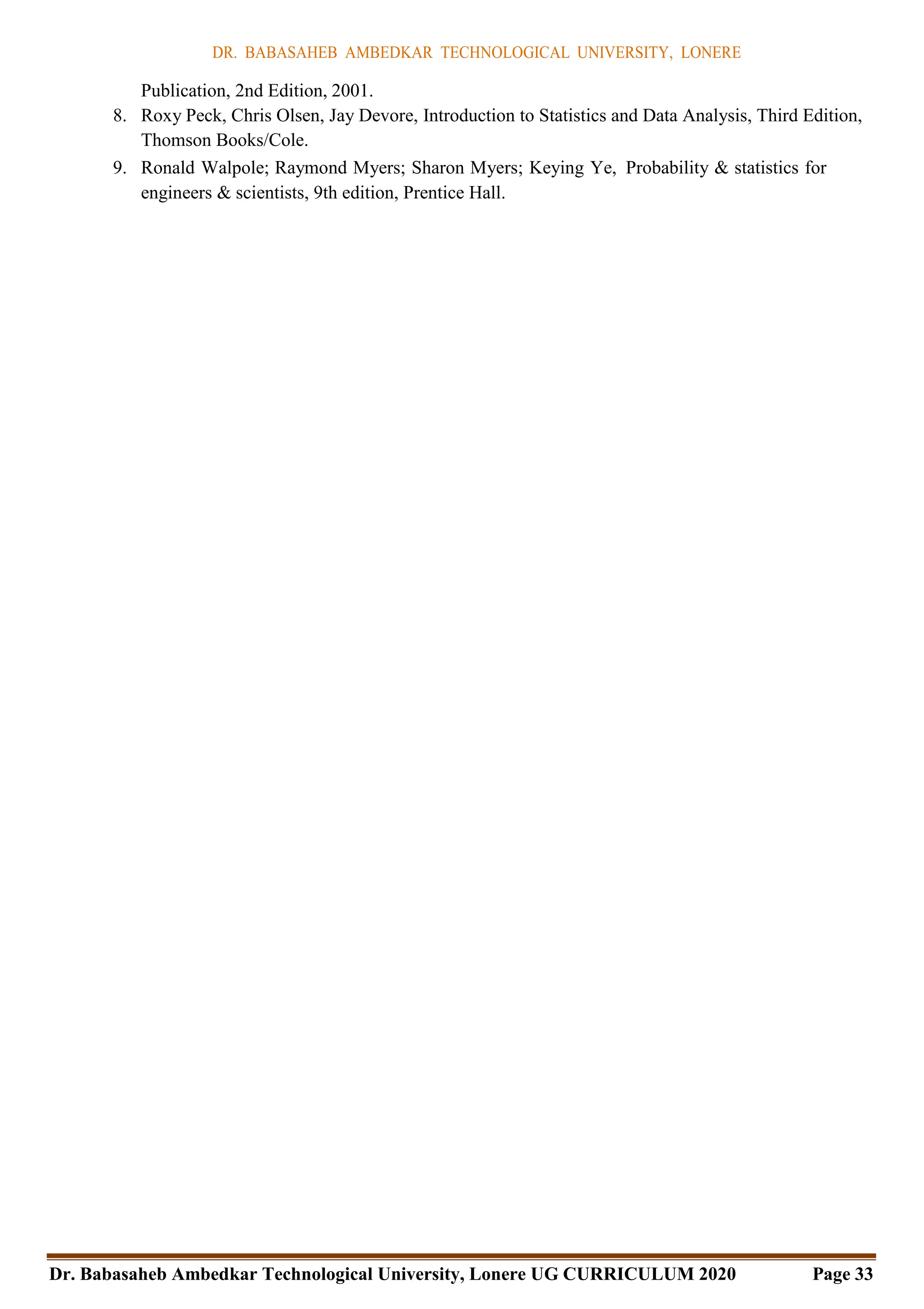
![DR. BABASAHEB AMBEDKAR TECHNOLOGICAL UNIVERSITY, LONERE
Dr. Babasaheb Ambedkar Technological University, Lonere UG CURRICULUM 2020 Page 34
BTES405: Digital Logic Design & Microprocessor
[Unit1] Introduction [7 Hours]
Digital signals, digital circuits, AND, OR, NOT, NAND, NOR and Exclusive-OR operations, Boolean algebra,
examples of IC gates, Number Systems: binary, signed binary, octal hexadecimal number, binary arithmetic,
one‘s and two‘s complements arithmetic, codes, error detecting and correcting codes.
[Unit 2] Combinational Digital Circuits [7 Hours]
Standard representation for logic functions, K-map representation, simplification of logic functions using K-
map, minimization of logical functions, Don‘t care conditions, Multiplexer, De-Multiplexer / Decoders,Adders,
Subtractors, BCD arithmetic, carry look ahead adder, serial adder, ALU, elementary ALU design, parity checker
/ generator.
[Unit 3] Sequential circuits and systems [7 Hours]
1-bit memory, the circuit properties of Bistable latch, the clocked SR flip flop, J-K-T and D-types flip flops,
applications of flip flops, shift registers, applications of shift registers, serial to parallel converter, parallel to
serial converter, ring counter, sequence generator, ripple(Asynchronous) counters, synchronous counters,
counters design using flip flops, special counter IC‘s, asynchronous sequential counters, applications of
counters.
[Unit 4] Fundamentals of Microprocessors [7 Hours]
Fundamentals of Microprocessor, Comparison of 8-bit, (8085) 16-bit (8086), and 32-bit microprocessors
(80386), The 8086 Architecture: Internal Block Diagram, CPU, ALU, address, data and control bus, Working
registers, SFRs, Clock and RESET circuits, Stack and Stack Pointer, Program Counter, I/O ports, Memory
Structures, Data and Program Memory, Timing diagrams and Execution Cycles.
[Unit 5] 8086 Instruction Set and Programming [7 Hours]
Memory Interfacing, I/O Interfacing, Direct Memory Access (DMA), Interrupts in 8086, 8086 Instruction Set
and Programming: Addressing modes: Introduction, Instruction syntax, Data types, Subroutines Immediate
addressing, Register addressing, Direct addressing, Indirect addressing, Relative addressing, Indexed
addressing, Bit inherent addressing, bit direct addressing, Instruction timings, Data transfer instructions,
Arithmetic instructions, Logical instructions, Branch instructions, Subroutine instructions, Bit manipulation
instruction, Assembly language programs, C language programs, Assemblers and compilers, Programming
and debugging tools.
Text Book:
1. R. P.Jain, Modern Digital Electronics, McGraw Hill Education, 2009.
Reference Books:
1. M. M. Mano, Digital logic and Computer design, Pearson Education India, 2016.
2. Kumar, Fundamentals of Digital Circuits, Prentice Hall India, 2016.
3. Douglas Hall, Microprocessors and Interfacing, McGraw-Hill Publication, Revised 2nd Edition,
2006.](https://image.slidesharecdn.com/dbatusyllabus-240425025908-3b234bc1/75/Dbatu-syllabus-basic-human-rights-of-SY-computer-science-engineering-of-DBATU-34-2048.jpg)
![DR. BABASAHEB AMBEDKAR TECHNOLOGICAL UNIVERSITY, LONERE
Dr. Babasaheb Ambedkar Technological University, Lonere UG CURRICULUM 2020 Page 35
BTCOL406: Python Programming
One hour per week is for program demonstration and instruction which can be conducted as a
classroom session or lab session.
[Unit 1] [2 Hours]
Informal introduction to programming, algorithms and data structures, downloading and installing Python, run
a simple program on Python interpreter.
[Unit 2] [2 Hours]
Variables, operations, control flow – assignments, conditionals, loops, functions: optional arguments, default
values, passing functions as arguments.
[Unit 3] [2 Hours]
Statements, Expressions, Strings: String processing. Exception handling, Basic input/output, handling files.
[Unit 4] [2 Hours]
Class and Object, Data Structure: List, Tuple and Sequences, Set, Dictionaries.
[Unit 5] [4 Hours]
Using Database and Structured Query Languages (SQL): SQLite manager, Spidering Twitter using a
Database, Programming with multiple tables, JOIN to retrieve data.
*Programming assignments are mandatory.
Text Book:
1. Michael Urban and Joel Murach, Murach‘s Python Programming, Murach's Publication, 2016.
Reference Books:
1. Charles Severance, Python for Informatics: Exploring Information, University of Michigan,
Version 2.7.0, 2014.
2. Dr. R. Nageswara Rao, Core Python Programming, Dreamtech Press, 1st Edition, 2016.
3. Mark Lutz, Learning Python, O'Reilly Media, 5th Edition, 2013.
4. Mark Pilgrim, Dive into Python 3, A press Publication, 2nd Edition, 2009.
5. Allen B. Downey, Think Python, O'Reilly Media, 2nd Edition, 2012.
6. Jon Kleinberg and Eva Tardos, Algorithm Design, Pearson Education, 1st Edition, 2006.](https://image.slidesharecdn.com/dbatusyllabus-240425025908-3b234bc1/75/Dbatu-syllabus-basic-human-rights-of-SY-computer-science-engineering-of-DBATU-35-2048.jpg)
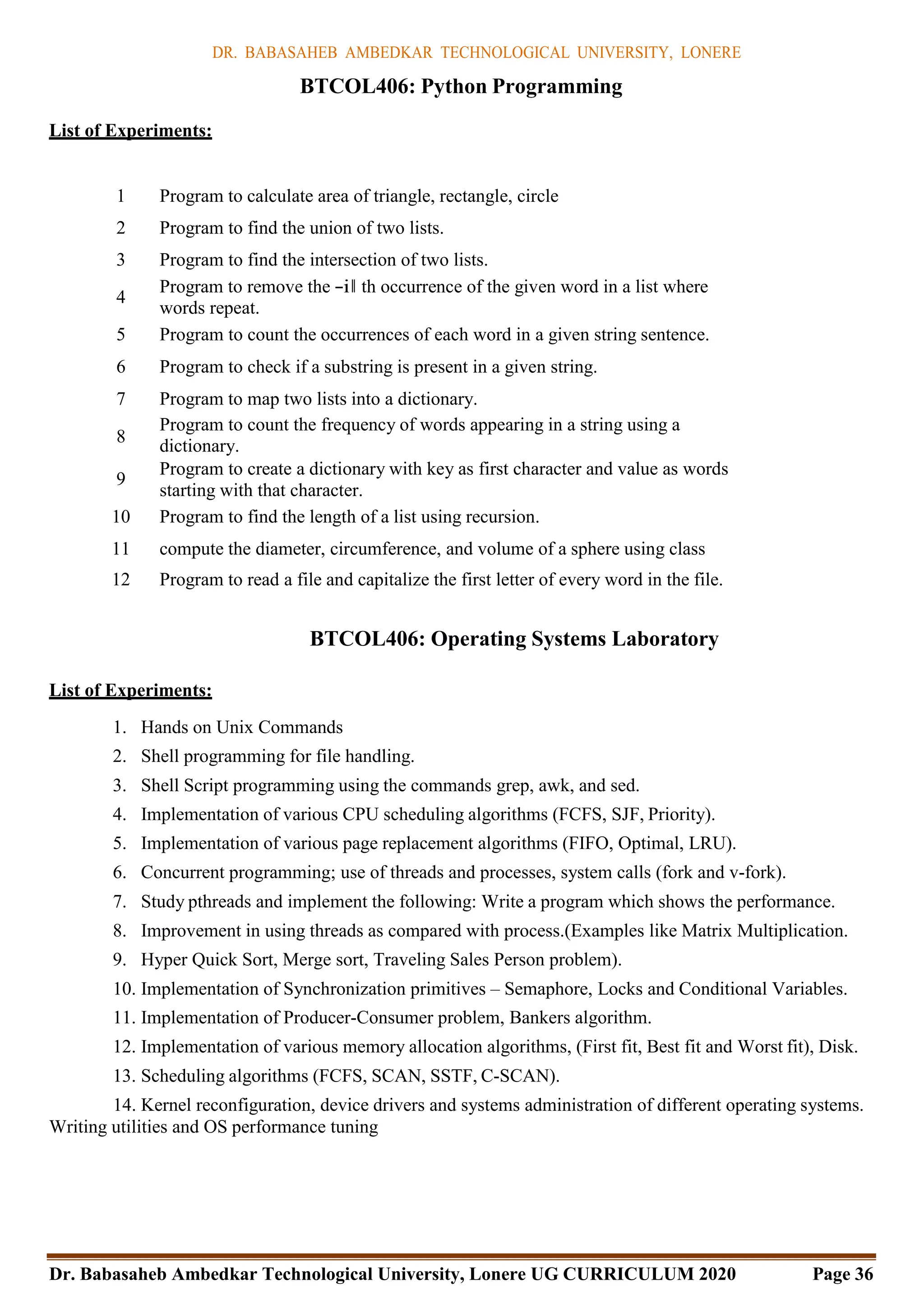
![DR. BABASAHEB AMBEDKAR TECHNOLOGICAL UNIVERSITY, LONERE
Dr. Babasaheb Ambedkar Technological University, Lonere UG CURRICULUM 2020 Page 37
[Unit 1]
BTCOS407: Seminar – II
Web Site development Essentials: Overview of Web Design Concepts, Web Project Management
Fundamentals, Web Site Development Process, HTML and the Evolution of Markup languages, HTML basic
tags, Web Page Layout and Elements, Create Hyperlinks, Create Tables, Create Web Forms, Image Inserting
Techniques, Create Frames, GUI HTML Editors, Site Content and Metadata.
[Unit 2]
Cascading Style Sheets: Cascading Style Sheets for Web page design, Creating CSS rules, Format Text with
CSS, Use of CSS Selectors, Embed Style Sheets, and Attach External Style Sheets. Using
CSS with Tables: Insert and Styling Tables, Import Table Data, Style Tables with CSS, Sort Data in Table.
[Unit 3]
Introduction to JavaScript, Variables, Basic in JavaScript — Numbers and operators, Handling text — Strings
in JavaScript, Useful string methods, Arrays, Troubleshooting JavaScript;
Programming fundamentals: If...Else Statements, Else...If Statements, For Loops, While Loops, Breaking Out
Of Loops, Switch Statements, Functions; JavaScript Events, Selecting HTML elements using get Element
ById().
[Unit 4]
PHP: Basic Syntax, Defining variable and constant, PHP Data type, Operator and Expression, Handling Html
Form with PHP: Capturing Form Data, Dealing with Multi-value filed, redirecting a form after submission, PHP
Session.
[Unit 5]
JQuery: Introduction to JQuery, Validation using JQuery, JQuery Forms, JQuery Examples
AJAX: Introduction to AJAX, PHP with AJAX Introduction to RDBMS: Connection with MySQL Database,
Performing basic database operation (DML)(Insert, Delete, Update, Select)
Suggestive List of Experiments:
1. Design an html form for displaying information using interactive css including images, tables.
2. Create a webpage with HTML describing your department with following specification:
a. Change the background color of the page. At the bottom create a link to take user to the top of
the page.
b. Insert an image and create a link such that clicking on image takes user to other page.
c. Also apply font styling like italics, underline and two other fonts to words you find appropriate.
Also use header tags.
3. Write a JavaScript to design a simple calculator to perform the following operations: sum, product,
difference and quotient.
4. Write a JavaScript to validate the following fields of employee on html form: email, name, mobile no.,
address, salary.
5. Develop and demonstrate a HTML file that includes JavaScript script that uses functions for the
following problems:
a. Parameter: A string
Output: Length of the String
b. Parameter: A number
Output: The number with its digits in the reverse order
6. Develop and demonstrate a HTML file that includes JavaScript for the following problems:
a. Input: A starting and ending number
b. Output: find all the prime numbers between starting and ending number.
7. Write a PHP program to display a digital clock which displays the current time of the server.](https://image.slidesharecdn.com/dbatusyllabus-240425025908-3b234bc1/75/Dbatu-syllabus-basic-human-rights-of-SY-computer-science-engineering-of-DBATU-37-2048.jpg)
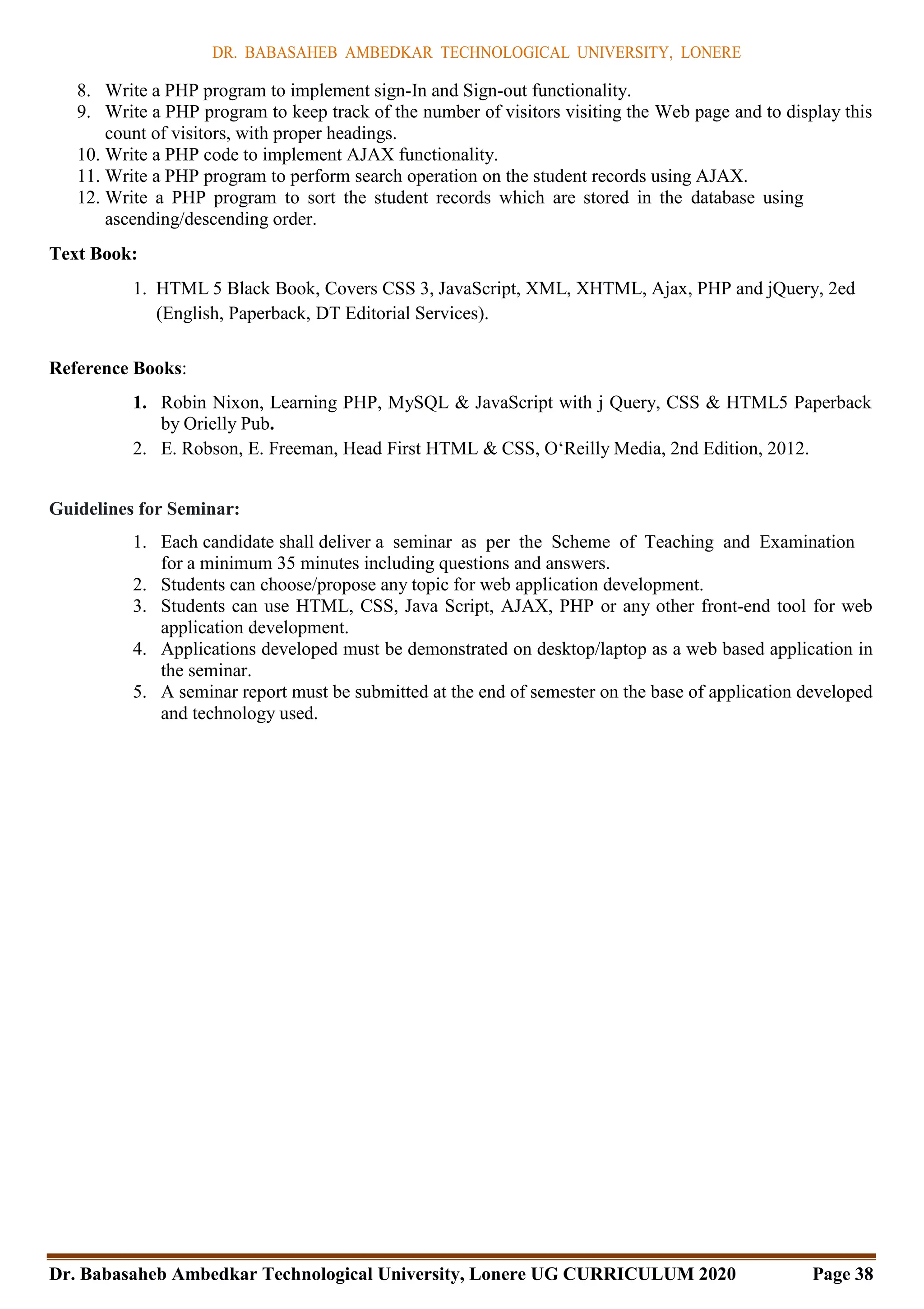
![DR. BABASAHEB AMBEDKAR TECHNOLOGICAL UNIVERSITY, LONERE
Dr. Babasaheb Ambedkar Technological University, Lonere UG CURRICULUM 2020 Page 39
BTCOC501: Database Systems
[Unit 1] Introduction [7 Hours]
Database System Applications, Purpose of Database Systems, View of Data, Database Languages, Relational
Databases, Database Design, Data Storage and Querying, Transaction Management, Database Architecture Data
modeling using the Entity Relationship Model: ER model concepts, notation for ER diagram, Constraints, keys,
E-R Diagrams, Mapping Cardinality, Concepts of Super Key, candidate key, primary key, weak entity sets,
Codd‘s rules, Extended ER model, Generalization, Aggregation, , Reduction of an ER diagrams to tables.
[Unit 2] Relational Data Model, Relational Algebra and Calculus [7 Hours]
Structure of Relational Databases, Database Schema, Keys Relational algebra: Fundamental Operations,
Additional Relational Algebra Operations, Extended Relational Algebra Operations. Calculus: Tuple relational
calculus, Domain relational Calculus, calculus vs algebra, computational capabilities.
[Unit 3] Introduction to SQL [7 Hours]
Overview of SQL, SQL Data Definition, Basic Structure of SQL Queries, Additional Basic Operators, Set
Operations, Null Values, Aggregate Functions, Nested Sub queries, Modification of the Database Intermediate
SQL : Join Expressions, Views, Transactions, Integrity Constraints, SQL Data Types and Schema,
Authorization, Advanced SQL : Assessing SQL from Programming Language, JDBC, ODBC, Embedded SQL,
Functions and Procedures, Triggers,
[Unit 4] Relational Database Design and File Organization, Indexing & Hashing [7 Hours]
Normalization: Features of good relational designs, Functional dependencies, Normal forms, First, Second,
Third normal forms, BCNF, Functional Dependency Theory, Multivalued Dependencies, Fourth Normal Form,
Database Design Process.
File Organization, Ordered Indices, B+tree Index files, B Tree Index File, Static Hashing, Dynamic Hashing,
[Unit 5] Transaction Processing [7 Hours]
Transaction Concept, A simple Transaction Model, Transaction Atomicity and Durability, Transaction
Isolation, ACID Properties, Serializability Concurrency Control Techniques: Lock based Protocols, Deadlock
handling, Multiple Granularity, Time stamp-Based Protocols, Recovery System.
Text Book:
1. Henry Korth, Abraham Silberschatz & S. Sudarshan, Database System Concepts, McGraw-
Hill Publication, 6th Edition, 2011.
Reference Books:
1. Raghu Ramakrishnan, Johannes Gehrke, Database Management Systems, McGraw-
HillPublication, 3rd
Edition, 2003.
2. Joel Murach, Murach's Oracle SQL and PL/SQL for Developers, Mike Murach & Associates,
2nd Edition, 2014.
3. Wiederhold, Database Design, McGraw-Hill Publication, 2nd Edition, 1983.
4. Navathe, Fundamentals of Database System, Addison-Wesley Publication, 6th Edition, 2012.
5. Mark L. Gillenson, Fundamentals of Database Management System, Wiley Publication,
2nd
Edition, 2011.
6. Serge Abiteboul, Richard Hull, Victor Vianu, ―Foundations of Databases‖, Reprint by
Addison-Wesley.](https://image.slidesharecdn.com/dbatusyllabus-240425025908-3b234bc1/75/Dbatu-syllabus-basic-human-rights-of-SY-computer-science-engineering-of-DBATU-39-2048.jpg)
![DR. BABASAHEB AMBEDKAR TECHNOLOGICAL UNIVERSITY, LONERE
Dr. Babasaheb Ambedkar Technological University, Lonere UG CURRICULUM 2020 Page 40
BTCOC502: Theory of Computation
[Unit 1] Finite Automata and Regular Expressions [7 Hours]
Definition of deterministic finite automata, Non-deterministic finite automata, Moore and Mealy machines and
their conversions, Regular expressions, Recursive definition, NFA with e-moves, Inter-conversion between
NFA and DFA, Regular expression and FA, Pumping lemma.
[Unit 2] Context Free Grammars [7 Hours]
Definition, Production rules, Ambiguous grammar, Removal of ambiguity, Chomsky hierarchy, Context Free
Grammar (CFG) – definition, Simplification of CFG.
[Unit 3] Context Free Languages [7 Hours]
Definition of context free languages, Regular grammar definition, Left linear, Right linear grammar, Inter-
conversion between left linear and right linear regular grammar, Regular grammar and finite automata, CNF,
GNF, Derivation graphs, Type 0 and Type 1grammars.
[Unit 4] Push down Automata [7 Hours]
Formal definition, Pushdown automata (PDA), Deterministic Pushdown automata (DPDA) – definition, Non-
deterministic Pushdown automata (NPDA) - definition, relative powers of DPDA and NPDA.
[Unit 5] Turing Machines and Undecidability [7 Hours]
Definition, Computing with Turing machine, Extensions of Turing machines, Random access Turing machines,
Non-deterministic Turing machines, Grammars, The Church‘s Turing hypothesis, Universal Turingmachines,
The Halting problem, Unsolvable problems about Turing machines.
Text Book:
1. Hopcroft, Ullman, Motwani, Introduction to Automata Theory, Languages, and Computation,
Addison Wesley Publication, 2nd Edition, 2001.
Reference Books:
1. Daniel I. A. Cohen, Introduction to Computer Theory, Wiley Publication, 1st Edition, 1986.
2. John C. Martin, Introduction to Languages and Theory of Computation, McGraw-Hill
Publication, 4th Edition, 2010.
3. Krithivasan Kamala, Introduction to Formal Languages, Automata Theory and Computation,
Pearson Education, 1st Edition, 2009.
4. Papadimitriou, Lewis, Elements of the Theory of Computations, PHI Publication, 2nd Edition,
1997.
5. E. V. Krishnamurthy, Introductory Theory of Computer Science, Springer-Velang New York Inc.,
1st Edition, 1985.](https://image.slidesharecdn.com/dbatusyllabus-240425025908-3b234bc1/75/Dbatu-syllabus-basic-human-rights-of-SY-computer-science-engineering-of-DBATU-40-2048.jpg)
![DR. BABASAHEB AMBEDKAR TECHNOLOGICAL UNIVERSITY, LONERE
Dr. Babasaheb Ambedkar Technological University, Lonere UG CURRICULUM 2020 Page 41
BTCOC503: Software Engineering
[Unit 1] [7 Hours]
Introduction: Professional software development, Software engineering ethics, Case studies. Software
processes: Software process models, Process activities, Coping with change, The rational unified process.
[Unit 2] [7 Hours]
Agile software development: Agile methods, Plan-driven and agile development, Extreme programming, Agile
project management, Scaling agile methods. Requirements engineering: Functional and non-functional
requirements, The software requirements document, Requirements specification, Requirements engineering
processes, Requirements elicitation and analysis, Requirements validation, Requirements management.
[Unit 3] [7 Hours]
System modeling: Context models, Interaction models, Structural models, Behavioral models, Model-driven
engineering. Architectural design: Architectural design decisions, Architectural views, Architectural patterns,
Application architectures.
[Unit 4] [7 Hours]
Design and implementation, Object-oriented design using UML, Design patterns Implementation issues, Open
source development.
[Unit 5] [7 Hours]
Software testing, Development testing, Test-driven development, Release testing, User testing. Dependability
properties, Availability and reliability, Safety Security.
Text Book:
1. Ian Sommerville, Software Engineering; 9th Edition, Addison-Wesley Publishing Company, USA.
Reference Books:
1. S.A. Kelkar, Software Engineering, , Prentice Hall of India, 2007.
2. Pressman, Software Engineering, Tata McGraw Hill, 6th Edition, 2006.
3. Pankaj Jalote, Software Engineering, Narosa Publishers, 3rd Edition, 2006.
NPTEL Course:
1. Software Engineering, Prof. Rajib Mall, Department of Computer Science and Engineering, IIT
Kharagpur.](https://image.slidesharecdn.com/dbatusyllabus-240425025908-3b234bc1/75/Dbatu-syllabus-basic-human-rights-of-SY-computer-science-engineering-of-DBATU-41-2048.jpg)
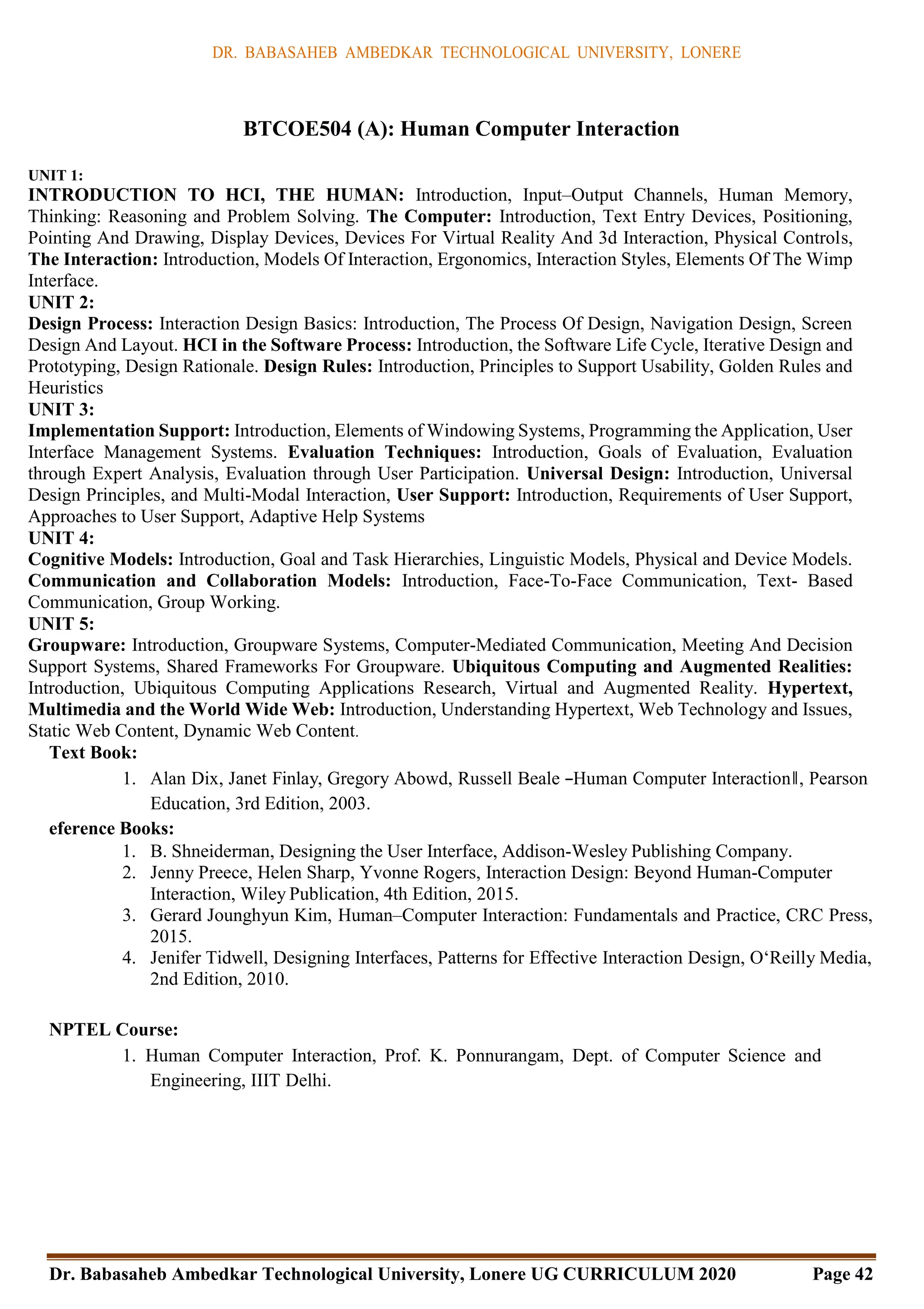
![DR. BABASAHEB AMBEDKAR TECHNOLOGICAL UNIVERSITY, LONERE
Dr. Babasaheb Ambedkar Technological University, Lonere UG CURRICULUM 2020 Page 43
BTCOE504 (B): Numerical Methods
[Unit 1] [7 Hours]
Solution of Algebraic and Transcendental Equation: Bisection method, Method of false position, Newton‘s
method and Newton-Raphson method.
[Unit 2] [7 Hours]
Solution of Linear Simultaneous Equation: Gauss elimination method, Gauss-Jordan method, Iterative method
of solution- Jacobi iteration method, Gauss-Seidal iteration method, Relaxation method.
[Unit 3] [7 Hours]
Finite Differences: Forward difference operator, Backward difference operator, Central difference operator,
New- ton‘s interpolation formulae, Newton‘s forward–backward-central interpolation formulae.
[Unit 4] [7 Hours]
Differentiation and Integration: Newton-Cortes formula, Trapezoidal rule, Simpson one–third rule, Simpson
three- eighth rule.
[Unit 5] [7 Hours]
Numerical Solution of ODE: Picard‘s methods, Taylor series method, Euler‘s method, Modified Euler‘s
method, Runge Kutta method.
Text Book:
1. B. S Grewal, Higher Engineering Mathematics, 40th edition, Khanna publication
Reference Books:
1. S. S. Shastri, Introduction to Numerical Methods, PHI publication.
2. V.Rajaraman, Computer Oriented Methods, 3rd edition, PHI publication.
3. Conte and De boor, Elementary Numerical Analysis, BPB publication.
4. E. Kreyszig, Advanced Engineering Mathematics, BPB publication.
5. Steven C Chapra, Numerical Methods for Engineers, 5th edition, McGraw Hill publication.
NPTEL Course:
1. Numerical Methods, Prof. Ameeya Kumar Nayak and Prof. Sanjeev Kumar, IIT Roorkee.](https://image.slidesharecdn.com/dbatusyllabus-240425025908-3b234bc1/75/Dbatu-syllabus-basic-human-rights-of-SY-computer-science-engineering-of-DBATU-43-2048.jpg)
![DR. BABASAHEB AMBEDKAR TECHNOLOGICAL UNIVERSITY, LONERE
Dr. Babasaheb Ambedkar Technological University, Lonere UG CURRICULUM 2020 Page 44
BTHM505 (A): Economics and Management
[Unit 1] [7 Hours]
Introduction, Market Equilibrium: Demand and Supply, Elasticity of Demand Forecasting, Production,
Exercises on Economics, Cost-Volume-Profit Relationships, Cost Management Systems and Activity Costing
System.
[Unit 2] [7 Hours]
Relevant Information and Decision Making, Cost Allocation, Exercises on Economics, Double-Entry
Bookkeeping, Job Casting, Process Costing, The Master Budget, Flexible Budgets and Variance Analysis.
[Unit 3] [7 Hours]
Financial Statements, Analysis of Financial Statements, Time Value of Money, Comparison of Alternatives.
[Unit 4] [7 Hours]
Depreciation Accounting, Evolution of Management Thoughts, Functions of Management Directing.
[Unit 5] [7 Hours]
Product Development, Forecasting Revisited, Capacity Planning, Product / Services Strategies and Plant
Layout, Production Planning and Control.
Text Book:
1. R. Paneerselvam, Engineering Economics, PHI publication.
Reference Books:
1. Robbins S.P. and Decenzo David A., Fundamentals of Management: Essential Concepts and
Applications, Pearson Education.
2. L. M. Prasad, Principles and Practices of Management.
3. K. K. Dewett & M. H. Navalur, Modern Economic Theory, S. Chand Publications.
NPTEL Course:
1. Economics / Management / Entrepreneurship, by Prof. P. K. J. Mohapatra Department of Industrial
Engineering & Management, IIT Kharagpur.](https://image.slidesharecdn.com/dbatusyllabus-240425025908-3b234bc1/75/Dbatu-syllabus-basic-human-rights-of-SY-computer-science-engineering-of-DBATU-44-2048.jpg)
![DR. BABASAHEB AMBEDKAR TECHNOLOGICAL UNIVERSITY, LONERE
Dr. Babasaheb Ambedkar Technological University, Lonere UG CURRICULUM 2020 Page 45
BTHM505 (B): Business Communication
[Unit 1] [6 Hours]
Introduction, Definitions & Concepts, Communicative Competence.
[Unit 2] [6 Hours]
Intercultural Communication, Nonverbal Communication, Thought and Speech, Translation as Problematic
Discourse.
[Unit 3] [6 Hours]
Barriers to Communication, Listening, Communication Rules, Communication Style.
[Unit 4] [6 Hours]
Interpersonal Communication, Relational Communication, Organizational Communication. Collaboration,
Communication in Groups and Teams, Persuasive Communication.
[Unit 5] [7 Hours]
Negotiation and Conflict Management, Leadership, Written Communication in International Business, Role
of Technology in international Business Communication, Moving to Another Culture, Crisis Communication,
Ethics in Business Communication.
Text Book:
1. Mary Ellen Guffey, Essentials of Business Communication, Sixth Edition, South-Western
College Publishing
Reference Books:
1. Bovee, Courtland, John Thill & Mukesh Chaturvedi, Business Communication Today: Dorling
kindersley, Delhi.
2. Kaul, Asha, Business Communication, Prentice-Hall of India, Delhi.
3. Monippally, Matthukutty M. Business Communication Strategies. Tata McGraw-Hill Publishing
Company Ltd., New Delhi.
4. Sharma, Sangeeta and Binod Mishra, Communication Skills for Engineers and Scientists, PHI
Learning Pvt. Ltd., New Delhi.
NPTEL Course:
1. International Business Communication, by Aradhana Malik, IIT Kharagpur.](https://image.slidesharecdn.com/dbatusyllabus-240425025908-3b234bc1/75/Dbatu-syllabus-basic-human-rights-of-SY-computer-science-engineering-of-DBATU-45-2048.jpg)
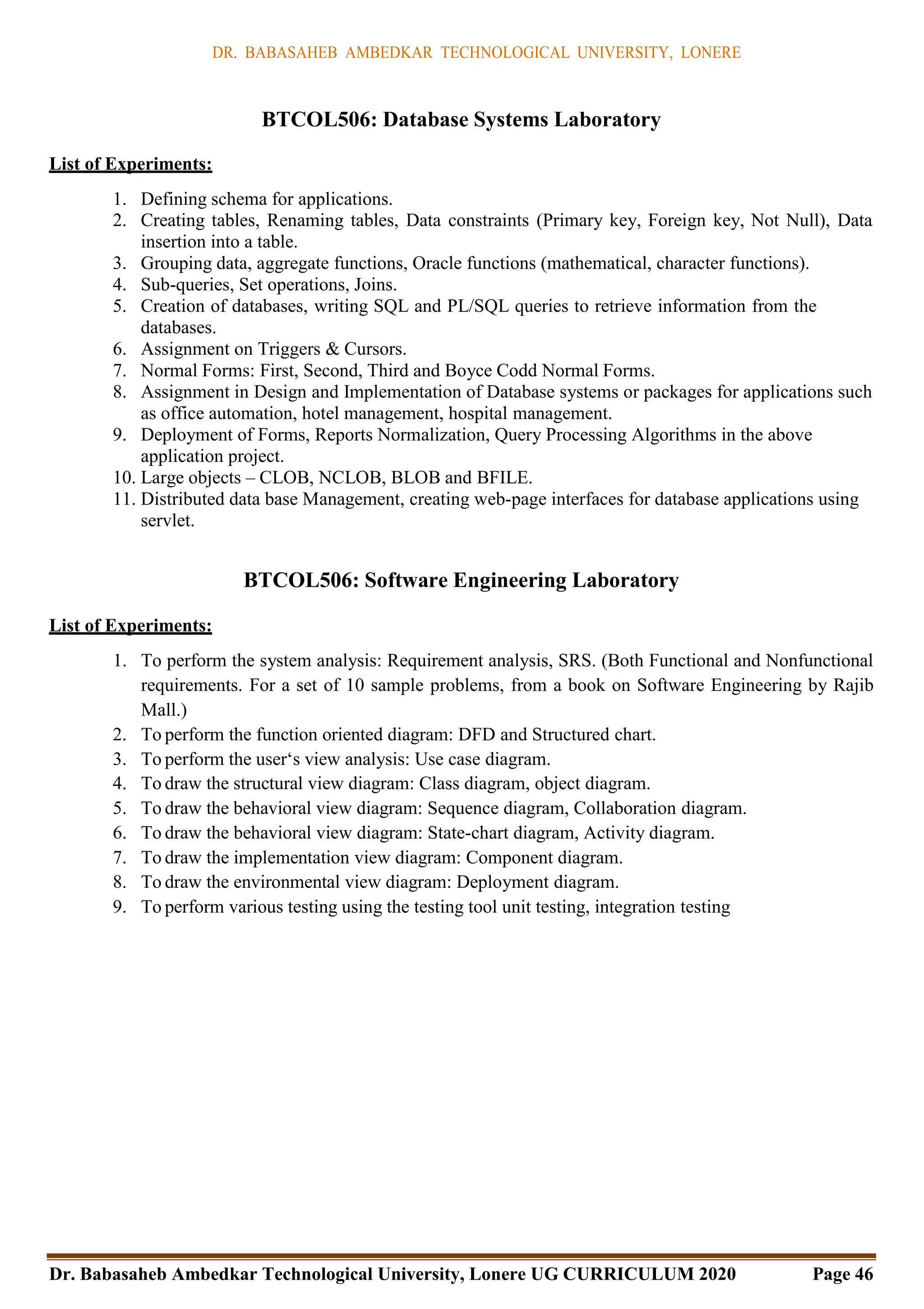
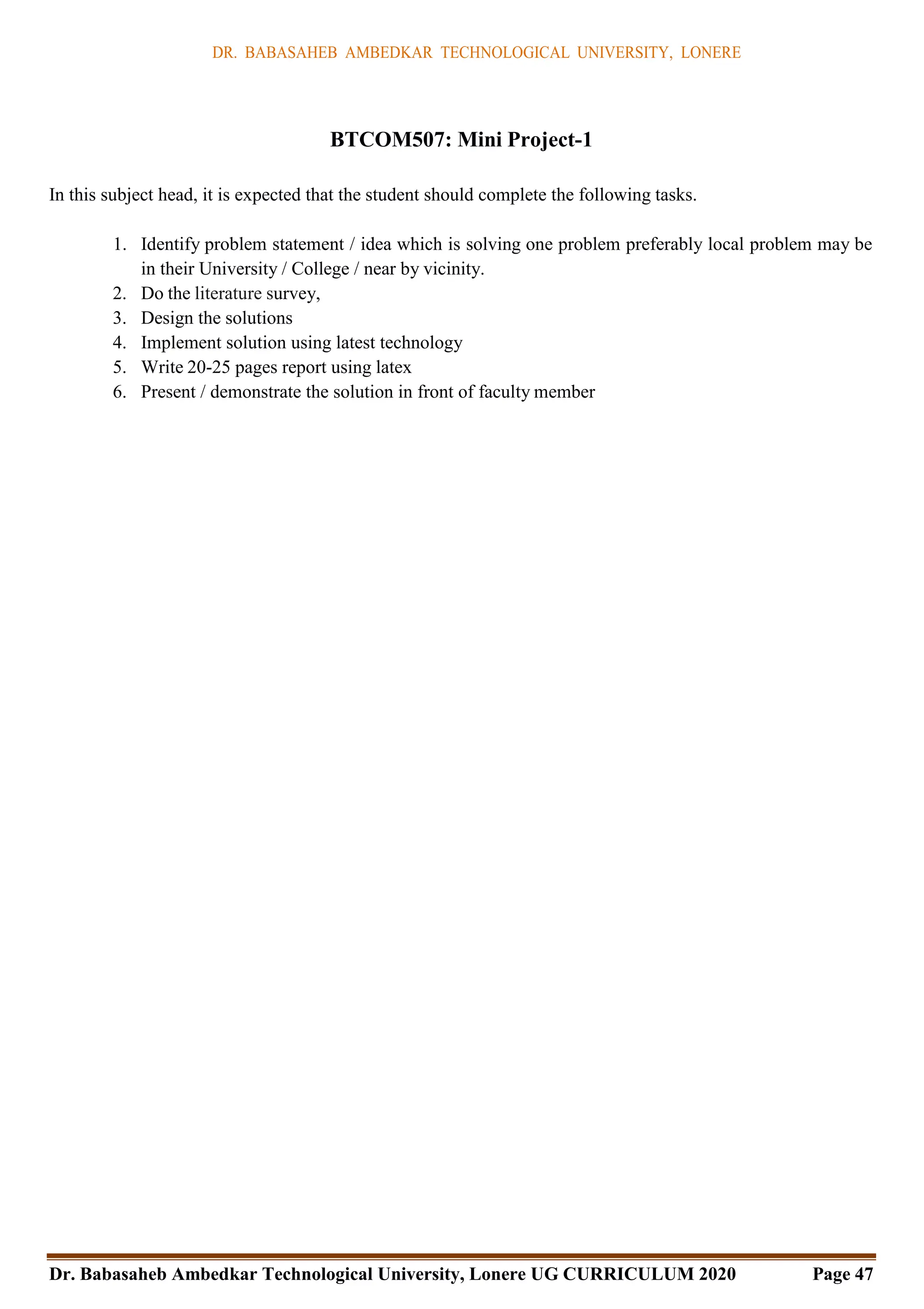
![DR. BABASAHEB AMBEDKAR TECHNOLOGICAL UNIVERSITY, LONERE
Dr. Babasaheb Ambedkar Technological University, Lonere UG CURRICULUM 2020 Page 48
BTCOC601: Compiler Design
[Unit 1] Introduction to Compiling [7 Hours]
Definition, analysis of the source program, the phases of a compiler, the grouping of phases, Compiler
Construction tools, A simple one-pass compiler,
[Unit 2] Lexical Analysis [7 Hours]
The role of the Lexical analyzer, Input buffering, Specification of Tokens, A Language for Specifying Lexical
Analyzers, Design of a Lexical Analyzer generator.
[Unit 3] Syntax Analysis [7 Hours]
The role of the Parser, Context-free grammars, Writing a Grammar, Top-Down Parsing, Bottom-Up Parsing,
Operator-precedence Parsing, LR Parsers, Using Ambiguous Grammars, Parser Generators.
[Unit 4] Syntax-Directed Translation [7 Hours]
Definitions, Construction of Syntax Trees, Bottom-Up Evaluation of S- Attributed definitions, Top-Down
Translation, Bottom-Up Evaluation of Inherited attributes. Intermediate Languages, Declarations, Assignment
Statements, Boolean Expressions, Case Statements, Back patching, Procedure Calls.
[Unit 5] Code Generation [7 Hours]
Issues in the Design of a Code Generator, The target Machine, Run-Time Storage Management, Basic Blocks
and Flow Graphs, Next-Use Information, Simple Code Generator, Register allocation and Assignment, The
DAG Representation of Basic Blocks, Generating Code from DAGs, Dynamic Programming, Code- Generation
Algorithm, Code-Generators.
Text Book:
1. Aho, Sethi, Ullman, Compilers Principles, Techniques and Tools, Pearson Education India, 2nd
Edition, 2013
Reference Books:
1. Hopcroft, Motwani and Ullman, Introduction to Automata Theory, Languages and
Computation, Pearson Publication, 2nd Edition, 2001.
2. Dick Grune, Kees van Reeuwijk, Henri E. Bal, Ceriel J. H. Jacobs and Koen Langendoen,
Modern Compiler Design, Springer, 2nd
Edition, 2012.](https://image.slidesharecdn.com/dbatusyllabus-240425025908-3b234bc1/75/Dbatu-syllabus-basic-human-rights-of-SY-computer-science-engineering-of-DBATU-48-2048.jpg)
![DR. BABASAHEB AMBEDKAR TECHNOLOGICAL UNIVERSITY, LONERE
Dr. Babasaheb Ambedkar Technological University, Lonere UG CURRICULUM 2020 Page 49
BTCOC602: Computer Networks
[Unit 1] Introduction [7 Hours]
Applications of computer networks, Network hardware, Network software: Protocol Hierarchy, Design Issue,
connection oriented vs. connectionless, Service Primitives, Reference models: OSI and TCP/IP, Example
networks: Internet, Network standardization, Performance: Bandwidth and Latency, Delay and bandwidth
product, High- Speed Network, Application Performance Needs.
[Unit 2] LAN Technologies [7 Hours]
X5, Frame relay, ATM, Ethernet (802.3), FDDI, Token Rings, Resilient Packet Rings, Wireless LANs: Wi-Fi
(802.11), Cell Phone Technologies, Broadband Wireless: Wi-MAX (802.16), Bluetooth (802.15.1),RFID.
[Unit 3] Data Link Layer [7 Hours]
Data Link Layer Design Issues: Service provided to network layer Framing, Error Control, Flow Control, Error
Detection and Correction: error correcting codes, error detecting codes.
[Unit 4] Network Layer and Congestion Control [7 Hours]
IPv4/IPv6, Routers and Routing Algorithms distance vector link state. TCP UDP and sockets, General
principles, Congestion prevention policies, Load shading, Jitter control, Quality of service: Packet scheduling,
Traffic shaping, integrated Services.
[Unit 5] Application Layer Protocols [7 Hours]
DNS, SMTP, POP, FTP, HTTP. Network Security: Authentication, Basics of public key and private key
cryptography, digital signatures and certificates, firewalls.
Text Book:
1. A. Tanenbaum, Computer Networks, PHI Publication, 5th Edition, 2011.
Reference Books:
1. B. Forouzan, Data Communications and Networking, McGraw Hill Publication, 5th Edition,
2013.
2. Larry Peterson and Bruce Davie, Computer Networks: A Systems Approach, Morgan Kufman
Publication, 5th Edition, 2012.
3. S. Keshav, An Engineering Approach to Computer Networking, Addison-WesleyProfessional.
4. D. Comer, Computer Networks and Internet, Pearson Education, 6th Edition, 2014.
5. M. Gallo, W. Hancock, Computer Communications and Networking Technologies,
Brooks/Cole Publisher, 2001.
6. Natalia Olifer, Victor Olifer, Computer Networks: Principles, Technologies and Protocols for
Network Design, Wiley Publication, 2005.](https://image.slidesharecdn.com/dbatusyllabus-240425025908-3b234bc1/75/Dbatu-syllabus-basic-human-rights-of-SY-computer-science-engineering-of-DBATU-49-2048.jpg)
![DR. BABASAHEB AMBEDKAR TECHNOLOGICAL UNIVERSITY, LONERE
Dr. Babasaheb Ambedkar Technological University, Lonere UG CURRICULUM 2020 Page 50
BTCOC603: Machine Learning
[Unit 1] [7 Hours]
Basic definitions, types of learning, hypothesis space and inductive bias, evaluation, cross-validation, Linear
regression, Decision trees, over fitting, Instance based learning, Feature reduction, Collaborative filtering based
recommendation
[Unit 2] [7 Hours]
Probability and Bayes learning, Logistic Regression, Support Vector Machine, Kernel function and Kernel
SVM.
[Unit 3] [7 Hours]
Perceptron, multilayer network, back propagation, introduction to deep neural network.
[Unit 4] [7 Hours]
Computational learning theory, PAC learning model, Sample complexity, VC Dimension, Ensemble learning.
[Unit 5] [7 Hours]
Clustering k-means, adaptive hierarchical clustering, Gaussian mixture model.
Text Book:
1. Tom Mitchell, Machine Learning, First Edition, McGraw Hill, 1997.
Reference Books:
1. Ethem Alpaydin, Introduction to Machine Learning, 2nd Edition,](https://image.slidesharecdn.com/dbatusyllabus-240425025908-3b234bc1/75/Dbatu-syllabus-basic-human-rights-of-SY-computer-science-engineering-of-DBATU-50-2048.jpg)
![DR. BABASAHEB AMBEDKAR TECHNOLOGICAL UNIVERSITY, LONERE
Dr. Babasaheb Ambedkar Technological University, Lonere UG CURRICULUM 2020 Page 51
BTCOE604 (A): Geographic Information System
[Unit 1] [6 Hours]
What is Geographic Information Systems?, Different components of GIS, Different types of vector data, Raster
data models and their types TIN data model.
[Unit 2] [6 Hours]
Advantages and disadvantages associated with vector, raster and TIN Non-spatial data attributes and their type
Raster data compression techniques Different raster data file formats spatial database systems and their types.
[Unit 3] [6 Hours]
Pre-processing of spatial datasets Different map projections, Spatial interpolation techniques Different types
of resolutions Digital Elevation Model (DEM).
[Unit 4] [6 Hours]
Quality assessment of freely available DEMS GIS analysis-1
[Unit 5] [6 Hours]
GIS analysis-2 and applications Errors in GIS Key elements of maps.
Text Book:
1. Ian Heywood, Sarah Cornelius and Steve Carver, An Introduction to Geographical
Information Systems (4th Edition) 2012.
Reference Books:
1. Chang Kang-tsung (Karl), Introduction to Geographic Information Systems, 2006
2. Tor Bernhardsen Geographic Information Systems: An Introduction, May 2002
NPTEL Course:
1. Dr. Arun K. Saraf, Introduction to Geographical Information System, IIT Roorkee.](https://image.slidesharecdn.com/dbatusyllabus-240425025908-3b234bc1/75/Dbatu-syllabus-basic-human-rights-of-SY-computer-science-engineering-of-DBATU-51-2048.jpg)
![DR. BABASAHEB AMBEDKAR TECHNOLOGICAL UNIVERSITY, LONERE
Dr. Babasaheb Ambedkar Technological University, Lonere UG CURRICULUM 2020 Page 52
BTCOE604 (B): Internet of Things
[Unit 1] IoT Introduction [7 Hours]
Genesis of IoT, IoT and Digitization, IoT Impact, Convergence of IT and IoT, IoT Challenges, IoT Network
Architecture and Design, Drivers Behind New Network Architectures, Comparing IoT Architectures, A
Simplified IoT Architecture, The Core IoT Functional Stack, IoT Data Management and ComputeStack.
[Unit 2] Smart Objects [7 Hours]
The ―Things‖ in IoT, Sensors, Actuators, and Smart Objects, Sensor Networks, Connecting Smart Objects,
Communications Criteria, IoT Access Technologies.
[Unit 3] IP Layer [7 Hours]
IP as the IoT Network Layer, The Business Case for IP, The need for Optimization, Optimizing IP for IoT,
Profiles and Compliances, Application Protocols for IoT, The Transport Layer, IoT Application Transport
Methods.
[Unit 4] Data and Analytics for IoT [7 Hours]
An Introduction to Data Analytics for IoT, Machine Learning, Big Data Analytics Tools and Technology, Edge
Streaming Analytics, Network Analytics, Securing IoT, A Brief History of IoT Security, Common Challenges
in IoT Security, Formal Risk Analysis Structures: OCTAVE and FAIR, The Phased Applicationof Security
in an Operational Environment
[Unit 5] IoT Physical Devices and Endpoints [7 Hours]
Building iot with Arduino: Arduino–Interfaces-Arduino IDE–Programming, RaspberryPi: Introduction to
RaspberryPi, About the RaspberryPi Board: Hardware Layout, Operating Systems on RaspberryPi, Configuring
RaspberryPi, Programming RaspberryPi with Python, Wireless Temperature Monitoring System Temperature
Sensor, Connecting Raspberry Pi via SSH, Accessing Temperature from sensors, Remote access to RaspberryPi,
Smart and Connected Cities, An IoT Strategy for Smarter Cities, Smart City IoT Architecture,Smart City
Security Architecture, Smart City Use-Case Examples.
Text Book:
1. David Hanes, Gonzalo Salgueiro, Patrick Grossetete, Robert Barton, Jerome Henry, "IoT
Fundamentals: Networking Technologies, Protocols, and Use Cases for the Internet Things‖,
1st
Edition, Pearson Education.
Reference Books:
1. Srinivasa K G, ―Internet of Things‖, CENGAGE Leaning India, 2017.
2. Vijay Madisetti and Arshdeep Bahga, ―Internet of Things (A Hands-on-Approach)‖, 1st
Edition, VPT, 2014.
3. Raj Kamal, ―Internet of Things: Architecture and Design Principles‖, 1st Edition, McGraw Hill
Education, 2017.](https://image.slidesharecdn.com/dbatusyllabus-240425025908-3b234bc1/75/Dbatu-syllabus-basic-human-rights-of-SY-computer-science-engineering-of-DBATU-52-2048.jpg)
![DR. BABASAHEB AMBEDKAR TECHNOLOGICAL UNIVERSITY, LONERE
Dr. Babasaheb Ambedkar Technological University, Lonere UG CURRICULUM 2020 Page 53
BTCOE604 (C): Embedded Systems
[Unit 1] [7 Hours]
Introduction: Embedded system overview, Design challenge, Processor technology, IC technology, Design
technology, Custom single processor technology, Hardware-combinational logic, Sequential logic, Custom
single purpose processor design, RT-level custom single purpose processor design, Optimizing custom single
purpose processors.
[Unit 2] [7 Hours]
General purpose processor Software: Basic architecture, Operation, Programmers view, Development
environment, Application specific instruction set processor, Selecting a microprocessor, General purpose
processor design. Introduction, ARM7TDMI-S processor, Block diagram, Memory mapping, Memory
accelerator module.
[Unit 3] [7 Hours]
System control: Pin description, Register description, Crystal oscillator, External interrupt inputs, Other
system controls, Memory mapping control, Phase locked loop, Power control, Reset, APB divider, Wakeup
timer. GPIO: GPIO register map, Timer-TIMER / COUNTER0 and TIMER / COUNTER1 register map,
Example timer operation, Architecture.
[Unit 4] [7 Hours]
UART: UART0/1 - UART0/1 register map, UART0/1 baud rate, UART0/1 auto-baud, UART0/1 block
diagram. Serial peripheral interface: SPI data transfers, SPI pin description, SPI register map, SPI block
diagram; I2C-bus interface: I2C bus configuration, I2C operating modes, I2C Bus serial interface block
diagram, Summary of I2C registers.
[Unit 5] [7 Hours]
Introduction, Process scheduling, Examples of RTOS, Microprocessor and microcontroller based system
design, typical design examples, system design and simulation using simulation software such as Proteus VSM.
Digital Camera Example Introduction, Introduction to a Simple Digital Camera; User‘s Perspective, Designer‘s
perspective requirements specification non functional requirements, Informal functional specification, refined
functional specification.
Text Book:
1. Frank Vahid ―Embedded System Design- A Unified system Hardwar/Software Introduction‖, (3rd
Edition, John Wiley India) ISBN 978-81-265-0837-2.
Reference Books:
1. LPC 214x User manual (UM10139):- www.nxp.com..
2. Andrew N. Sloss, Dominic Symes and Chris Wright ―ARM System Developer‘s Guide –
Designing and Optimizing System Software‖, (Elsevier) ISBN: 1-55860-874-5.
3. LPC 17xx User manual (UM10360) :- www.nxp.com
4. ARM architecture reference manual : - www.arm.com
5. Steve Furber ―An Engineer‘s Introduction to the LPC2100 series‖ Trevor Martin (Hitex (UK)
Ltd.).―ARM System-on-Chip Architecture‖ (2nd Edition, Addison-Wesley Professional)ISBN-
13: 9780201403527](https://image.slidesharecdn.com/dbatusyllabus-240425025908-3b234bc1/75/Dbatu-syllabus-basic-human-rights-of-SY-computer-science-engineering-of-DBATU-53-2048.jpg)
![DR. BABASAHEB AMBEDKAR TECHNOLOGICAL UNIVERSITY, LONERE
Dr. Babasaheb Ambedkar Technological University, Lonere UG CURRICULUM 2020 Page 54
BTHM605 (A): Development Engineering
[Unit 1] [7 Hours]
Introduction, Various Definitions of Development Engineering.
[Unit 2] [7 Hours]
World Poverty and Development, Poverty in the India, Sustainable Development, Culture and Global
Competence, The Engineer‘s Role.
[Unit 3] [7 Hours]
Social Justice, Social Justice and Engineering, Religious Perspectives, Secular Perspectives.
[Unit 4] [7 Hours]
Development Strategies: Society, Technological Change, and Development, Development Economists‘
Perspectives, Global Health Perspective, International Education Perspective, Social Business Perspectives.
[Unit 5] [7 Hours]
Engineering for Sustainable Community Development: The Engineer as a Helper Participatory Community
Development, Teamwork and Project Management, Community Assessment: Learning About a Community,
Project Selection, Humanitarian Technology, Participatory Technology Development, Humanitarian STEM
Education. ICT for Development, AI for Humanitarian purposes, Blockchain and Social Development.
Text Book:
1. Kevin M. Passino, Humanitarian Engineering: Advancing Technology for Sustainable
Development.](https://image.slidesharecdn.com/dbatusyllabus-240425025908-3b234bc1/75/Dbatu-syllabus-basic-human-rights-of-SY-computer-science-engineering-of-DBATU-54-2048.jpg)
![DR. BABASAHEB AMBEDKAR TECHNOLOGICAL UNIVERSITY, LONERE
Dr. Babasaheb Ambedkar Technological University, Lonere UG CURRICULUM 2020 Page 55
BTHM605 (B): Employability and Skill Development
[Unit 1] Soft Skills & Communication basics: [7 Hours]
Soft skills Vs hard skills, Skills to master, Interdisciplinary relevance, Global and national perspectives on
soft skills, Resume, Curriculum vitae, How to develop an impressive resume, Different formats of resume
Chronological, Functional, Hybrid, Job application or cover letter, Professional presentation- planning,
preparing and delivering presentation, Technical writing.
[Unit 2] Arithmetic and Mathematical Reasoning and Analytical Reasoning and Quantitative Ability:
[7 Hours]
Aspects of intelligence, Bloom taxonomy, multiple intelligence theory, Number sequence test, mental
arithmetic (square and square root, LCM and HCF, speed calculation, reminder theorem).
Matching, Selection, Arrangement, Verifications (Exercises on each of these types). Verbal aptitude (Synonym,
Antonym, Analogy).
[Unit 3] Grammar and Comprehension: [7 Hours]
English sentences and phrases, Analysis of complex sentences, Transformation of sentences, Paragraphwriting,
Story writing, Reproduction of a story, Letter writing, précis writing, Paraphrasing and e-mail writing.
[Unit 4] Skills for interviews: [7 Hours]
Interviews- types of interviews, preparatory steps for job interviews, interview skill tips, Group discussion-
importance of group discussion, types of group discussion, difference between group discussion, panel
discussion and debate, personality traits evaluated in group discussions, tips for successful participation in group
discussion, Listening skills- virtues of listening, fundamentals of good listening, Non-verbal communication-
body movement, physical appearance, verbal sounds, closeness, time.
[Unit 5] Problem Solving Techniques: [7 Hours]
Problem solving model: 1. Define the problem, 2. Gather information, 3. Identify various solution, 4. Evaluate
alternatives, 5. Take actions, 6. Evaluate the actions.
Problem solving skills: 1. Communicate. 2. Brain storming, 3. Learn from mistakes.
Text Book:
1. R. Gajendra Singh Chauhan, Sangeeta Sharma, ―Soft Skills- An integrated approach to maximize
personality‖, ISBN: 987-81-265-5639-7, First Edition 2016
Reference Books:
1. Wiley Wren and Martin, "English grammar and Composition", S. Chand publications.
2. R. S. Aggarwal, "A modern approach to verbal reasoning", S. Chand publications.
3. Philip Carter, "The Complete Book of Intelligence Test", John Willey & Sons Ltd.
4. Philip Carter, Ken Russell, "Succeed at IQ test", Kogan Page.
5. Eugene Ehrlich, Daniel Murphy, "Schaum;s Outline of English Grammar", McGraw Hills.
6. David F. Beer, David A. McMurrey, ―A Guide to Writing as an Engineer‖, ISBN: 978- 1-118-
30027-5 4th Edition, 2014, Wiley.](https://image.slidesharecdn.com/dbatusyllabus-240425025908-3b234bc1/75/Dbatu-syllabus-basic-human-rights-of-SY-computer-science-engineering-of-DBATU-55-2048.jpg)
![DR. BABASAHEB AMBEDKAR TECHNOLOGICAL UNIVERSITY, LONERE
Dr. Babasaheb Ambedkar Technological University, Lonere UG CURRICULUM 2020 Page 56
BTHM605 (C): Consumer Behavior
[Unit 1] [7 Hours]
Introduction to the Study of Consumer Behavior: Defining Consumer Behavior, Scope and Application of
Consumer Behavior, Why Study Consumer Behavior, Evolution of Consumer Behavior as a Field Of Study and
its relationship with Marketing: Behavioral Dimension, The Interdisciplinary Nature of Consumer Behavior.
Market Research and Consumer Behavior, Relevance of Market Research with Consumer Behavior,
Approaches to Consumer Behavior Research, Quantitative Research, Qualitative Research.
[Unit 2] [7 Hours]
Market Segmentation and Positioning, Market Segmentation, Basis for Segmentation, Alternatives available
for Segmentation, Positioning. The Consumer Decision Making Process: Buying Motives, Buying Roles,
Consumer Decision Making Process, Levels of Consumer Decision Making, Perspectives to Consumer
Decision Making, Consumer Decision Making Process.
[Unit 3] [7 Hours]
Models of Consumer Behavior: The Economic model, Learning model, Psychoanalytic model, The sociological
model. The Howard Sheth model of Buying Behaviour, The Nicosia model, The Engel - Kollat - Blackwell
Model, Engel, Blackwell and Miniard (EBM) model.
[Unit 4] [7 Hours]
Psychological Influences on Consumer Decision Making: Consumers Needs & Motivation, Emotions and
Mood, Consumer Involvement, Consumer Learning, Personality, Self-concept and Self-image, Consumer
Perception, Risk and Imagery. Consumer Attitude: Belief, Affect, Attitude and Intention, Attitude Formation
and Attitude Change, Consumer Communication. Sociological Influences on Consumer Decision Making:
Consumer groups, Consumer reference groups, Family and Life cycle, Social class and mobility, lifestyle
analysis, Culture; Sub-Culture, Cross Culture, Interpersonal Communication and influence, Opinion
Leadership.
[Unit 5] [7 Hours]
Diffusion of innovation Diffusion Process, Adoption Process, Consumer Innovators, Multiplicative innovation
adoption (MIA) model. Organizational Buying: Differences between Industrial Markets and Consumer
Markets, Differences between Organizational and Consumer Buying, Buying Decisions in Organizational
Buying Process, Types of Decision Making, Organization Buyer's Decision Making Process, and Factors
influencing Organizational Buying Behaviour, Decision Makers in Organizational Buying, Webster and Wind
model of Organizational buying behaviour, The Sheth model of Industrial buying, The Sheth model of Industrial
buying Consumer Behavior Analysis and Marketing Strategy: Consumer Behavior and Product Strategy,
Consumer Behavior and Pricing Strategy, Consumer Behavior and Distribution Channel Strategy, Consumer
Behavior and Promotion Strategy.
Text Book:
1. Consumer Behavior, Schiffman, L.G. and Kanuk L.L., Prentice Hall, India.
Reference Books:
1. Consumer Behavior, Concepts and Applications, Loudon, D.L. and Bitta, A.J.D, Tata
McGrawHill.
2. Consumer Behavior and Marketing Startegy, Peter, J.P. and Olson, J.C., Schiffman, L.G. and
Kanuk L.L., Prentice Hall, India.](https://image.slidesharecdn.com/dbatusyllabus-240425025908-3b234bc1/75/Dbatu-syllabus-basic-human-rights-of-SY-computer-science-engineering-of-DBATU-56-2048.jpg)
![DR. BABASAHEB AMBEDKAR TECHNOLOGICAL UNIVERSITY, LONERE
Dr. Babasaheb Ambedkar Technological University, Lonere UG CURRICULUM 2020 Page 57
BTCOL606: Competitive Programming
[Unit 1] [7 Hours]
Introduction: Online Judge The Programming Challenges Robot Judge, Understanding Feedback From the
Judge, Choosing Programming Languages, Reading Our Programs, Standard Input/Output, Programming Hints,
Elementary Data Types.
Challenging Problems
(1) The 3n + 1 Problem (2) Minesweeper (3) The Trip, (4) LCD Display (5) Graphical Editor (6) Interpreter
(7) Check the Check (8) Australian Voting.
[Unit 2] [7 Hours]
Elementary Data Structures: Data Structures: Elementary Data Structures, Stacks, Dictionaries, Priority Queues
Sets, Object Libraries, The C++ Standard Template Library, The Java java.util Package, Program Design
Example: Going to War, Hitting the Dec, String Input/Output, Winning the War, Testing and Debugging.
Challenging Problems
(1) Jolly (2) Poker Hands (3) Hartals (4) Crypt Kicker (5) Stack ‘em Up (6) Erd¨os Numbers (7) Contest
Scoreboard (8) Yahtzee.
[Unit 3] [7 Hours]
Strings: Character Codes, Representing Strings, Program Design Example: Corporate Renamings, Searching
for Patterns, Manipulating Strings, Completing the Merger, String Library Functions.
Challenging Problems
(1) WERTYU (2) Where‘s Waldorf? (3) Common Permutation (4) Crypt Kicker II (5) Automated Judge
Script (6) File Fragmentation (7) Doublets (8) Fmt
[Unit 4] [7 Hours]
Sorting: Sorting, Sorting Applications Sorting Algorithms, Program Design Example: Rating the Field,
Sorting Library Functions, Rating the Field.
Challenging Problems
(1) Vito‘s Family (2) Stacks of Flapjacks (3) Bridge (4) Longest Nap (5) Shoemaker‘s Problem (6) CDVII (7)
Shell Sort (8) Football.
[Unit 5] [8 Hours]
Arithmetic and Algebra: Machine Arithmetic, Integer Libraries, High-Precision Integers, High-Precision
Arithmetic, Numerical Bases and Conversion, Real Numbers, Dealing With Real Numbers, Fractions,
Decimals, Algebra, Manipulating Polynomials, Root Finding, Logarithms, Real Mathematical Libraries.
Challenging Problems
(1) Primary Arithmetic (2) Reverse and Add (3) The Archeologist‘s Dilemma (4) Ones (5) A Multiplication
Game (6) Polynomial Coefficients (7) The Stern-Brocot Number System (8) Pairsumonious Numbers.
Combinatorics: Basic Counting Techniques, Recurrence Relations, Binomial Coefficients, Other Counting
Sequences, Recursion and Induction Problems.
Challenging Problems
(1) How Many Fibs? (2) How Many Pieces of Land? (3) Counting (4) Expressions (5) Complete Tree
Labeling (6) The Priest Mathematician (7) Self-describing Sequence (8) Steps](https://image.slidesharecdn.com/dbatusyllabus-240425025908-3b234bc1/75/Dbatu-syllabus-basic-human-rights-of-SY-computer-science-engineering-of-DBATU-57-2048.jpg)
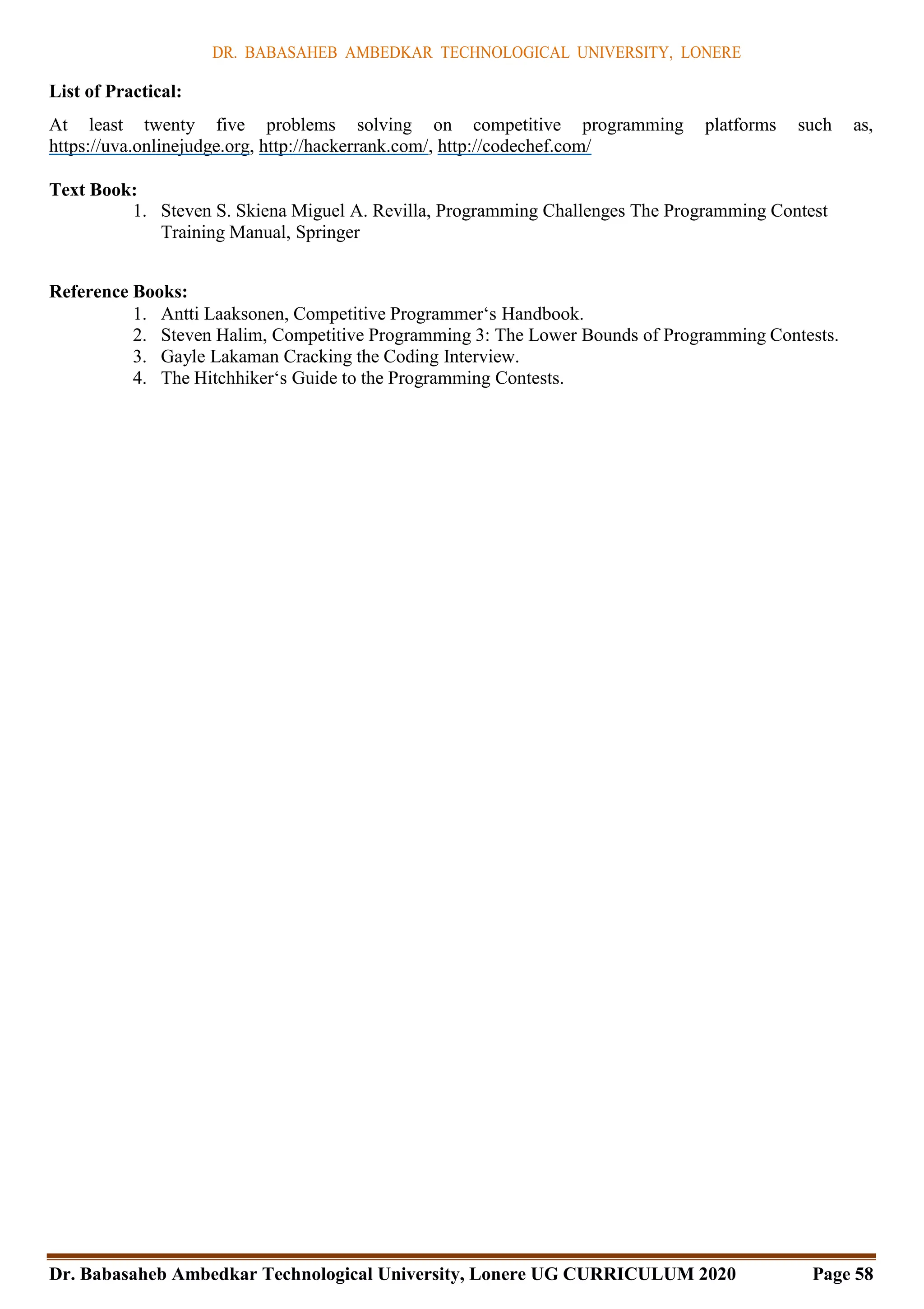

![DR. BABASAHEB AMBEDKAR TECHNOLOGICAL UNIVERSITY, LONERE
Dr. Babasaheb Ambedkar Technological University, Lonere UG CURRICULUM 2020 Page 60
BTCOC701: Artificial Intelligence
[Unit1] Introduction [7 Hours]
What Is AI? The Foundations of Artificial Intelligence, the History of Artificial Intelligence, the State of the
Art. Intelligent Agents: Agents and Environments Good Behavior: The Concept of Rationality, The Nature of
Environments, The Structure of Agents.
[Unit2]Problem-solving [7 Hours]
Solving Problems by Searching, Problem-Solving Agents, Example Problems, Searching for Solutions,
Uninformed Search Strategies, Informed (Heuristic) Search Strategies, Heuristic Functions, Defining Constraint
Satisfaction Problems, Constraint Propagation: Inference in CSPs, Backtracking Search for CSPs, Local Search
for CSPs, The Structure of Problems. Adversarial Search, Games, Optimal Decisions in Games, Alpha–Beta
Pruning.
[Unit 3]Knowledge & Reasoning [7 Hours]
Knowledge representation issues, Representation & mapping, Approaches to knowledge representation, Issues
in knowledge representation. Using predicate logic: Representing simple fact in logic, Representing instant &
ISA relationship, Computable functions & predicates, Resolution, Natural deduction. Representing knowledge
using rules: Procedural verses declarative knowledge, Logic programming, Forward verses backward
reasoning, Matching, Control knowledge.
[Unit 4]Probabilistic Reasoning [7 Hours]
Representing knowledge in an uncertain domain, The semantics of Bayesian networks, Dempster-Shafer
theory, Fuzzy sets & fuzzy logics,
Planning: Overview, Components of a planning system, Goal stack planning, Hierarchical planning and other
planning techniques.
[Unit5]Natural Language processing: [7 Hours]
Introduction, Syntactic processing, Semantic analysis, Discourse & pragmatic processing.
Learning: Forms of learning, Inductive learning, Learning decision trees, explanation based learning, Learning
using relevance information, Neural net learning & genetic learning. Expert Systems: Representing and using
domain knowledge, Expert system shells and knowledge acquisition.
Text Book:
1. Rich, E. and Knight K.: Artificial Intelligence, Tata McGraw- Hill
Reference Books:
1. Peter Norvig, Artificial Intelligence: A Modern Approach, Third Edition.
2. Ivan Bratko, Prolog Programming for Artificial Intelligence, Addison-Wesley.](https://image.slidesharecdn.com/dbatusyllabus-240425025908-3b234bc1/75/Dbatu-syllabus-basic-human-rights-of-SY-computer-science-engineering-of-DBATU-60-2048.jpg)
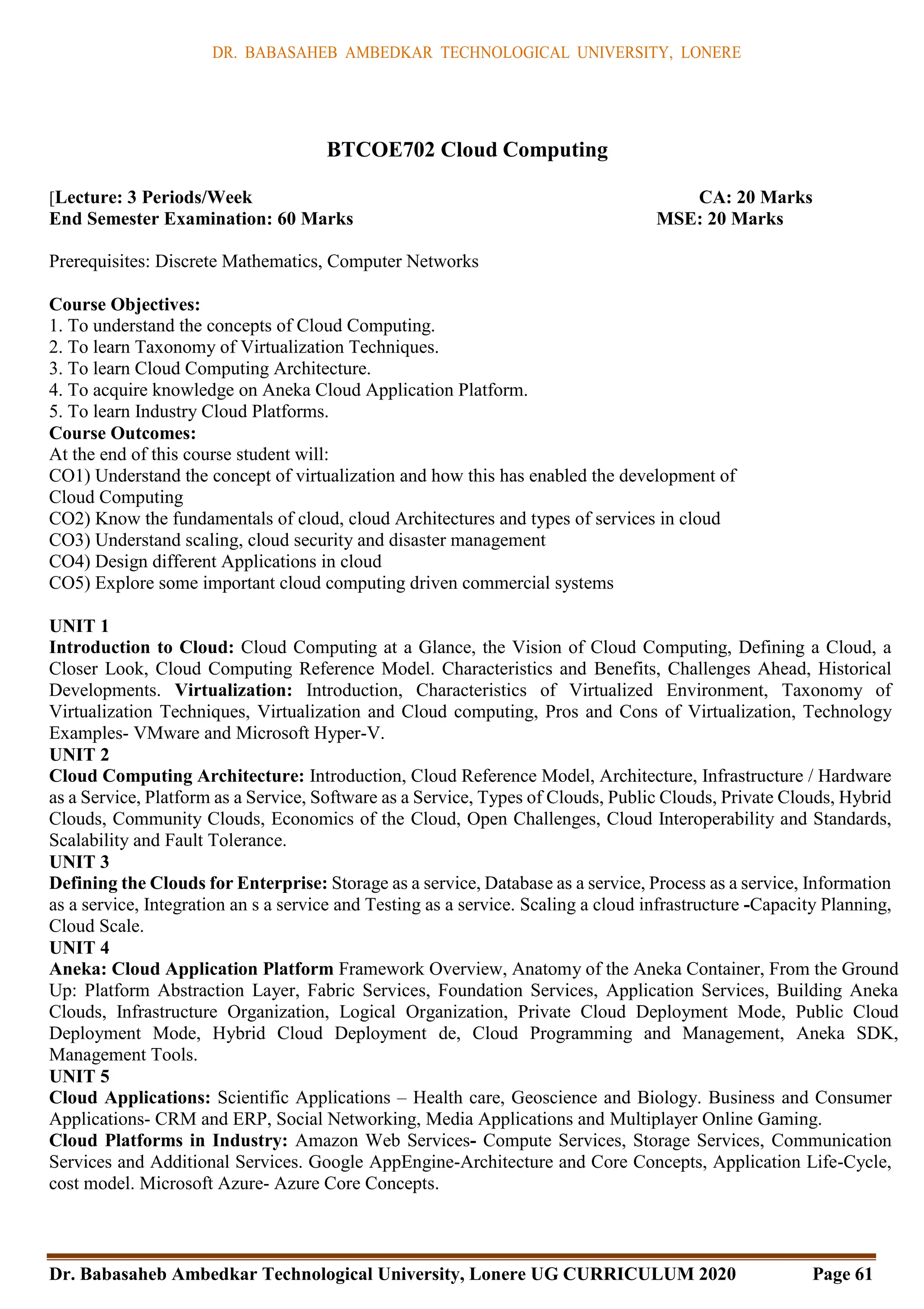
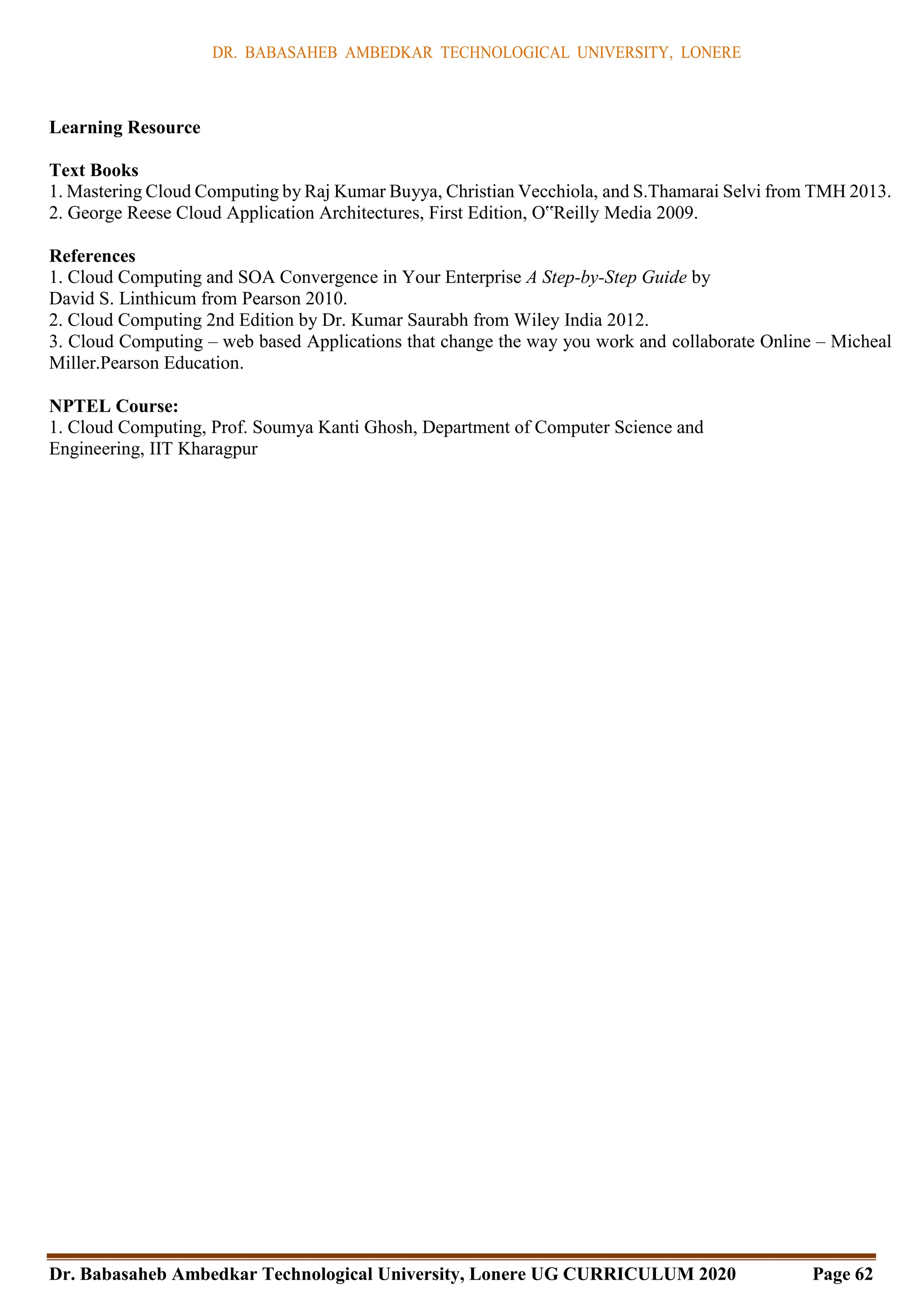
![DR. BABASAHEB AMBEDKAR TECHNOLOGICAL UNIVERSITY, LONERE
Dr. Babasaheb Ambedkar Technological University, Lonere UG CURRICULUM 2020 Page 63
BTCOE703 (A): Bioinformatics
[Unit 1] Introduction to Bioinformatics [6 Hours]
The Brain of Biotechnology Evolutionary Biology Origin & History of Bioinformatics Origin of
Bioinformatics/Biological Databases Importance of Bioinformatics Use of Bioinformatics Basics of Molecular
Biology Definitions of Fields Related to Bioinformatics Applications. Biological Databases: Introduction
Categories of Biological Databases The Database Industry Classification of Biological DatabasesThe Creation
of Sequence Databases Bioinformatics Programs and Tools Bioinformatics Tools Application ofProgrammes
in Bioinformatics.
[Unit 2] Genomics & Proteomics [7 Hours]
DNA, Genes and Genomes DNA Sequencing Genome Mapping Implications of Genomics for MedicalScience
Proteomic Application of Proteomics to Medicine Difference between Proteomics and Genomics Protein
Modeling. Sequence Alignment: Introduction Pairwise Sequence Alignment Sequence Alignment (MSA)
Substitution Matrices Two Sample Applications.
[Unit 3] Phylogenetic Analysis [7 Hours]
Introduction Fundamental Elements of Phylogenetic Models Tree Interpretation Importance of Identifying
Paralogs and Orthologs Phylogenetic Data Analysis Alignment Building the Data Model Determining the
Substitution Model Tree-Building Methods Tree Evaluation. Microarray Technology: A Boon to Biological
Sciences Introduction to Microarray Microarray Technique Potential of Microarray Analysis Microarray
Products Microarray Identifying Interactions Applications of Microarrays.
[Unit 4] Bioinformatics in Drug Discovery [6 Hours]
A Brief Overview Introduction Drug Discovery Informatics and Medical Sciences Bioinformatics and Medical
Sciences Bioinformatics in Computer-Aided Drug Design Bioinformatics Tools.
[Unit 5] Human Genome Project [6 Hours]
Human Genome Project: Introduction Human Genome Project Genome Sequenced in the Public (HGP) and
Private Project Funding for Human Genome Sequencing DNA Sequencing Bioinformatics Analysis: Finding
Functions Insights Learned from the Human DNA Sequence Future Challenges.
Text Book:
1. S. C. Rastorgi et al, Bioinformatics Concepts Skills and Applications; 2nd Edition, CBS
Publishers & Distributors.
NPTEL Course:
1. Prof. M. Michael Gromiha, Algorithms and Applications.](https://image.slidesharecdn.com/dbatusyllabus-240425025908-3b234bc1/75/Dbatu-syllabus-basic-human-rights-of-SY-computer-science-engineering-of-DBATU-63-2048.jpg)
![DR. BABASAHEB AMBEDKAR TECHNOLOGICAL UNIVERSITY, LONERE
Dr. Babasaheb Ambedkar Technological University, Lonere UG CURRICULUM 2020 Page 64
BTCOE703 (B): Distributed Systems
[Unit1]Introduction [7 Hours]
Introduction to Distributed Computing System, Evolution of Distributed Computing System, Distributed
Computing System models, Distributed Computing System Gaining Popularity, Distributed Operating System,
Introduction to Distributed Computing Environment (DCE), Desirable Features of a Good Message- Passing
System, Issues in IPC by Message-Passing, Synchronization, Buffering, Multidatagram message, Encoding and
Decoding of message data, Process addressing, Failure Handling, Group Communication, Case Study: BSD
UNIX IPC Mechanism.
[Unit 2] Remote Procedure Calls [7 Hours]
RPC model, Transparency of RPC, Implementing RPC Mechanism, Stub Generation, RPC messages,
Marshaling arguments and Results, Server Management, Parameter Passing Semantics, Call Semantics,
Communication Protocols for RPCs, Complicated RPCs, Client- Server Binding, Exception Handling, Security,
Some Special Types of RPCs, Case studies: Sun RPC, DCE, RPC.
[Unit 3] Distributed Shared Memory [6 Hours]
General Architecture of DSM Systems, Design and Implementation Issues of DSM, Granularity, Structure of
Shared Memory Space, Consistency Models, Replacement Strategy, Thrashing, Other Approaches to DSM,
Heterogeneous DSM, Advantages of Synchronization: Clock Synchronization, Event Ordering, Mutual
Exclusion, Deadlock, Election Algorithms.
[Unit 4] Resource Management And Process Management [6 Hours]
Desirable Features of a Good Global Scheduling Algorithm, Task assignment Approach, Load-Balancing
Approach, load Sharing Approach, Process Migration, Threads.
[Unit 5] Distributed File System [6 Hours]
Desirable Features of a Good Distributed File System, File Models, File Accessing Models, File Sharing
Semantics, File Caching Schemes, File Replication, Fault Tolerance, Atomic Transactions, Design Principles,
Case Study: DCE Distributed File Service.
Text Book:
1. P. K. Sinha, Distributed Operating System, PHI Publication
Reference Books:
1. Colorouis, Distributed Systems, Addison Wesley Publication.
2. M. L. Liu, Distributed Computing: Principles and Applications, Addison-Wesley, 2004.
NPTEL Course:
1. Distributed Systems, Prof. Rajiv Mishra, IIT Patna.](https://image.slidesharecdn.com/dbatusyllabus-240425025908-3b234bc1/75/Dbatu-syllabus-basic-human-rights-of-SY-computer-science-engineering-of-DBATU-64-2048.jpg)
![DR. BABASAHEB AMBEDKAR TECHNOLOGICAL UNIVERSITY, LONERE
Dr. Babasaheb Ambedkar Technological University, Lonere UG CURRICULUM 2020 Page 65
BTCOE703 (C): Big Data Analytics
[Unit 1] Introduction to Big Data [6 Hours]
Why Big Data and Where did it come from?, Characteristics of Big, Challenges and applications of Big Data,
Enabling Technologies for Big Data, Big Data Stack, Big Data distribution packages.
[Unit 2] Big Data Platforms [7 Hours]
Overview of Apache Spark, HDFS, YARN, MapReduce, MapReduce Programming Model with Spark,
MapReduce Example: Word Count, Page Rank etc, CAP Theorem, Eventual Consistency, Consistency Trade-
O-s, ACID and BASE, Zookeeper and Paxos, Cassandra, Cassandra Internals, HBase, HBase Internals.
[Unit 3] Big Data Streaming Platforms [6 Hours]
Big Data Streaming Platforms for Fast Data, Streaming Systems, Big Data Pipelines for Real-Time computing,
Spark Streaming, Kafka, Streaming Ecosystem.
[Unit 4] Big Data Applications [6 Hours]
Overview of Big Data Machine Learning, Mahout, Big Data Machine learning Algorithms in Mahout-kmeans,
Naive Bayes etc. Machine learning with Spark, Machine Learning Algorithms in Spark, SparkMLlib,
Deep Learning for Big Data, Graph Processing: Pregel, Giraph, Spark GraphX.
[Unit 5] Database for the Modern Web [7 Hours]
Introduction to mongoDB key features, Core server tools, MongoDB through the JavaScript‘ sshell, Creating
and querying through Indexes, Document-oriented, principles of schema design, Constructing queries on
databases, collections and documents, MongoDB query language.
Text Book:
1. Bart Baesens ―Analytics in a Big Data World: The Essential Guide to Data Science and
its Applications‖, Wiley and SAS Business Series.
Reference Books:
1. Rajkumar Buyya, Rodrigo N. Calheiros, Amir M Vahid Dastjerdi, Morgan Kaufmann, ―Big
Data Principals and Paradiagram‖, Elsevier, ISBN: 978-0-12-805394-2
2. Kyle Banker, Peter Bakkum and Shaun Verch, ―MongoDB in Action‖, 2nd Edition Dream
tech Press, ISBN: 978-9351199359.
3. Anand Rajaraman, Jeffrey D. Ullman, ―Mining of Massive Datasets‖, 3rd edition,
Cambridge University Press
4. Sima Acharya, Subhashini Chhellappan, ―BIG Data and Analytics‖, ,Willey publication,
ISBN: 978-8126554782.
NPTEL COURSE:
1. Big Data Computing by Prof. Rajiv Misra, Dept. of Computer Science and Engineering,
IIT Patna](https://image.slidesharecdn.com/dbatusyllabus-240425025908-3b234bc1/75/Dbatu-syllabus-basic-human-rights-of-SY-computer-science-engineering-of-DBATU-65-2048.jpg)
![DR. BABASAHEB AMBEDKAR TECHNOLOGICAL UNIVERSITY, LONERE
Dr. Babasaheb Ambedkar Technological University, Lonere UG CURRICULUM 2020 Page 66
BTCOE704 (A): Cryptography & Network Security
[Unit 1] [6 Hours]
Introduction and Mathematical Foundations: Introduction, Overview on Modern Cryptography, Number
Theory, Probability and Information Theory. Classical Cryptosystems: Classical Cryptosystems, Crypt-
analysis of Classical Cryptosystems, Shannon‘s Theory.
[Unit 2] [6 Hours]
Symmetric Key Ciphers: Symmetric Key Ciphers, Modern Block Ciphers (DES), Modern Block Cipher
(AES).Crypt-analysis of Symmetric Key Ciphers: Linear Crypt-analysis, Differential Crypt-analysis, other
Crypt-analytic Techniques, Overview on S-Box Design Principles, Modes of operation of Block Ciphers.
[Unit 3] [6 Hours]
Stream Ciphers and Pseudo-randomness: Stream Ciphers, Pseudo-random functions. Hash Functions and
MACs: Hash functions: The Merkle Damgard Construction, Message Authentication Codes (MACs).
[Unit 4] [6 Hours]
Asymmetric Key Ciphers: Construction and Crypt-analysis: More Number Theoretic Results, The RSA
Cryptosystem, Primality Testing, Factoring Algorithms, Other attacks on RSA and Semantic Security of RSA,
The Discrete Logarithm Problem (DLP) and the Diffie-Hellman Key Exchange algorithm, The ElGamal
Encryption Algorithm, Crypt-analysis of DLP.
[Unit -5] [6 Hours]
Digital Signatures: Signature schemes: I, Signature schemes: II. Modern Trends in Asymmetric Key
Cryptography: Elliptic curve based cryptography: I, Elliptic curve based cryptography: II. Network Security:
Secret Sharing Schemes, A Tutorial on Network Protocols, Kerberos, Pretty Good Privacy (PGP), Secure Socket
Layer (SSL), Intruders and Viruses, Firewalls.
Text Book:
1. Douglas Stinson, "Cryptography Theory and Practice", 2nd Edition, Chapman & Hall/CRC.
Reference Books:
1. B. A. Forouzan, "Cryptography & Network Security", McGraw Hill Publication.
2. William Stallings, "Cryptography and Network Security", Pearson Education.
3. Dr. B. B. Meshram, TCP/IP & Network Security, SPD Publication.
4. Wenbo Mao, "Modern Cryptography, Theory & Practice", Pearson Education.
5. Hoffstein, Pipher, Silvermman, "An Introduction to Mathematical Cryptography", Springer.
6. Alang.Konheim, Computer Security and Cryptography, Wiley Publication.
7. A. Joux, "Algorithmic Crypt-analysis", CRC Press.
8. S. G. Telang, "Number Theory", McGraw Hill.
9. Matt Bishop, "Computer Security", Pearson Education.](https://image.slidesharecdn.com/dbatusyllabus-240425025908-3b234bc1/75/Dbatu-syllabus-basic-human-rights-of-SY-computer-science-engineering-of-DBATU-66-2048.jpg)
![DR. BABASAHEB AMBEDKAR TECHNOLOGICAL UNIVERSITY, LONERE
Dr. Babasaheb Ambedkar Technological University, Lonere UG CURRICULUM 2020 Page 67
BTCOE704 (B): Business Intelligence
[Unit 1] Business Intelligence Introduction [6 Hours]
Definition, Leveraging Data and Knowledge for BI, BI Components, BI Dimensions, Information Hierarchy,
Business Intelligence and Business Analytics, BI Life Cycle. Data for BI – Data Issues and Data Quality for
BI.
[Unit 2] BI Implementation [6 Hours]
Key Drivers, Key Performance Indicators and operational metrics, BI Architecture/Framework, Best Practices,
Business Decision Making. Business Analytics: Objective Curve, Web Analytics and Web Intelligence,
Customer Relationship Management.
[Unit 3] Business/Corporate Performance Management [6 Hours]
Dash Boards and Scorecards, Business Activity Monitoring, Six Sigma. Advanced BI: Big Data and BI, Social
Networks, Mobile BI, emerging trends. Working with BI Tools: Overview of managerial, strategic and technical
issues associated with Business Intelligence and Data Warehouse design, implementation, and utilization.
Critical issues in planning, physical design process, deployment and ongoing maintenance.
[Unit 4] Data Warehousing (DW) [6 Hours]
Data Warehousing (DW): Introduction & Overview; Data Marts, DW architecture – DW components,
Implementation options; Meta Data, Information delivery. ETL: Data Extraction, Data Transformation –
Conditioning, Scrubbing, Merging, etc., Data Loading, Data Staging, Data Quality.
[Unit 5] Dimensional Modeling [6 Hours]
Dimensional Modeling: Facts, dimensions, measures, examples; Schema Design – Star and Snowflake, Fact
constellation, slow changing Dimensions. OLAP: OLAP Vs OLTP, Multi-Dimensional Databases (MDD);
OLAP – ROLAP, MOLAP, HOLAP; Data Warehouse Project Management: Critical issues in planning,
physical design process, deployment and ongoing maintenance.
Text Book:
1. Efraim Turban, Ramesh Sharda, Jay Aronson, David King, Decision Support and Business
Intelligence Systems, 9th Edition, Pearson Education, 2009
Reference Books:
1. David Loshin, Business Intelligence – The Savy Manager's Guide Getting Onboard with
Emerging IT, Morgan Kaufmann Publishers, 2009.](https://image.slidesharecdn.com/dbatusyllabus-240425025908-3b234bc1/75/Dbatu-syllabus-basic-human-rights-of-SY-computer-science-engineering-of-DBATU-67-2048.jpg)
![DR. BABASAHEB AMBEDKAR TECHNOLOGICAL UNIVERSITY, LONERE
Dr. Babasaheb Ambedkar Technological University, Lonere UG CURRICULUM 2020 Page 68
BTCOE704 (C): Blockchain Technology
[Unit 1] Introduction [6 Hours]
Overview of Blockchain, Public Ledgers, Bitcoin, Smart Contracts, Block in a Blockchain, Transactions,
Distributed Consensus, Public vs. Private Blockchain, Understanding Crypto currency to Blockchain,
Permissioned Model of Blockchain, Overview of Security aspects of Blockchain. Basic Crypto Primitives:
Cryptographic Hash Function, Properties of a hash function, Hash pointer and Merkle tree, Digital Signature,
Public Key Cryptography, A basic crypto currency.
[Unit 2] Bitcoin and Blockchain [7 Hours]
Creation of coins, Payments and double spending, Bitcoin Scripts, Bitcoin P2P Network, Transaction in Bitcoin
Network, Block Mining, Block propagation and block relay. Working with Consensus in Bitcoin: Distributed
consensus in open environments, Consensus in a Bitcoin network, Proof of Work (PoW) – Hashcash PoW,
Bitcoin PoW, Attacks on PoW and the monopoly problem, Proof of Stake, Proof of Burn and Proof of Elapsed
Time, The life of a Bitcoin Miner, Mining Difficulty, Mining Pool.
[Unit 3] Permissioned Blockchain [7 Hours]
Permissioned model and use cases, Design issues for Permissioned blockchains, Execute contracts, State
machine replication, Overview of Consensus models for permissioned blockchain-Distributed consensus in
closed environment, Paxos, RAFT Consensus, Byzantine general problem, Byzantine fault tolerant system,
Lamport- Shostak-Pease BFT Algorithm, BFT over Asynchronous systems.
[Unit 4] Enterprise application of Blockchain [6 Hours]
Cross border payments, Know Your Customer (KYC), Food Security, Mortgage over Blockchain, Blockchain
enabled Trade, We Trade – Trade Finance Network, Supply Chain Financing, Identity on Blockchain.
[Unit 5] Blockchain Application Development [6 Hours]
Hyperledger Fabric- Architecture, Identities and Policies, Membership and Access Control, Channels,
Transaction Validation, Writing smart contract using Hyperledger Fabric, Writing smart contract using
Ethereum, Overview of Ripple and Corda.
Text Book:
1. Melanie Swan, ―Blockchain: Blueprint for a New Economy‖, O‘Reilly, 2015.
Reference Books:
1. Josh Thompsons, ―Blockchain: The Blockchain for Beginners-Guide to Blockchain
Technology and Leveraging Blockchain Programming‖.
2. Daniel Drescher, ―Blockchain Basics‖, Apress; 1st Edition, 2017.
3. Anshul Kaushik, ―Blockchain and Crypto Currencies‖, Khanna Publishing House, Delhi.
4. Imran Bashir, ―Mastering Blockchain: Distributed Ledger Technology, Decentralization and
Smart Contracts Explained‖, Packt Publishing.
5. Ritesh Modi, ―Solidity Programming Essentials: A Beginner‘s Guide to Build Smart Contracts
for Ethereum and Blockchain‖, Packt Publishing.
6. Salman Baset, Luc Desrosiers, Nitin Gaur, Petr Novotny, Anthony O‘Dowd, Venkatraman
Ramakrishna, ―Hands-On Block Chain with Hyperledger: Building Decentralized
Applications with Hyperledger Fabric and Composer‖, Import, 2018.
NPTEL Course:
1. Prof. Sandip Chakraborty, Department of Computer Science And Engineering, IIT Kharagpur
and Dr. Praveen Jayachandran, Research Staff Member, IBM.](https://image.slidesharecdn.com/dbatusyllabus-240425025908-3b234bc1/75/Dbatu-syllabus-basic-human-rights-of-SY-computer-science-engineering-of-DBATU-68-2048.jpg)
![DR. BABASAHEB AMBEDKAR TECHNOLOGICAL UNIVERSITY, LONERE
Dr. Babasaheb Ambedkar Technological University, Lonere UG CURRICULUM 2020 Page 69
BTCOE705 (A): Virtual Reality
[Unit 1] Introduction to Virtual Reality [6 Hours]
Virtual Reality and Virtual Environment: Computer graphics, Real time computer graphics, Flight Simulation,
Virtual environment requirement, benefits of virtual reality, Historical development of VR, Scientific Landmark
3D Computer Graphics: The Virtual world space, positioning the virtual observer, the perspective projection,
human vision, stereo perspective projection, 3D clipping, Colour theory, Simple 3D modelling, Illumination
models, Reflection models, Shading algorithms, Radiosity, Hidden Surface Removal, Realism- Stereographic
image.
[Unit 2] Geometric Modelling [6 Hours]
From 2D to 3D, 3D space curves, 3D boundary representation Geometrical Transformations: Frames of
reference, Modelling transformations, Instances, Picking, Flying, Scaling the VE, Collision detection Generic
VR system: Virtual environment, Computer environment, VR technology, Model of interaction, VR Systems.
[Unit 3] Virtual Environment [6 Hours]
Animating the Virtual Environment: The dynamics of numbers, Linear and Nonlinear interpolation, the
animation of objects, linear and non-linear translation, shape & object in betweening, free from deformation,
particle system.
[Unit 4] Physical Simulation [4 Hours]
Objects falling in a gravitational field, Rotating wheels, Elastic collisions, projectiles, simple pendulum, springs,
Flight dynamics of an aircraft.
[Unit 5] VR Hardware and Software [6 Hours]
Human factors: The eye, the ear, the somatic senses. VR Hardware: Sensor hardware, Head-coupled displays,
Acoustic hardware, Integrated VR systems. VR Software: Modelling virtual world, Physical simulation, VR
toolkits, Introduction to VRML.
VR Applications: Engineering, Entertainment, Science, Training. The Future: Virtual environment, modes of
interaction
Text Book:
1. John Vince, ―Virtual Reality Systems ―, Pearson Education Asia, 2007.
Reference Books:
1. Anand R., ―Augmented and Virtual Reality‖, Khanna Publishing House, Delhi.
2. Adams, ―Visualizations of Virtual Reality‖, Tata McGraw Hill, 2000.
3. Grigore C. Burdea, Philippe Coiffet, ―Virtual Reality Technology‖, Wiley Inter Science, 2nd
Edition, 2006.
4. William R. Sherman, Alan B. Craig, ―Understanding Virtual Reality: Interface, Application
and Design‖, Morgan Kaufmann, 2008.
5. www.vresources.org
6. www.vrac.iastate.edu
7. www.w3.org/MarkUp/VRM](https://image.slidesharecdn.com/dbatusyllabus-240425025908-3b234bc1/75/Dbatu-syllabus-basic-human-rights-of-SY-computer-science-engineering-of-DBATU-69-2048.jpg)
![DR. BABASAHEB AMBEDKAR TECHNOLOGICAL UNIVERSITY, LONERE
Dr. Babasaheb Ambedkar Technological University, Lonere UG CURRICULUM 2020 Page 70
BTCOE705 (B): Deep Learning
[Unit 1] [6 Hours]
History of Deep Learning, Deep Learning Success Stories, McCulloch Pitts Neuron, Thresholding Logic,
Perceptrons, Perceptron Learning Algorithm, Multilayer Perceptrons (MLPs), Representation Power of MLPs,
Sigmoid Neurons, Gradient Descent, Feed forward Neural Networks.
[Unit 2] [6 Hours]
FeedForward Neural Networks, Backpropagation. Gradient Descent (GD), Momentum Based GD, Nesterov
Accelerated GD, Stochastic GD, AdaGrad, RMSProp. Principal Component Analysis and its interpretations,
Singular Value Decomposition.
[Unit 3] [6 Hours]
Auto encoders and relation to PCA, Regularization in auto encoders, Denoising auto encoders, Sparse auto
encoders, Contractive auto encoders. Regularization: Bias Variance Tradeoff, L2 regularization, Early stopping,
Dataset augmentation, Parameter sharing and tying. Greedy Layer wise Pre-training, Better activation functions,
Better weight initialization methods, Batch Normalization.
[Unit 4] [6 Hours]
Convolutional Neural Networks, LeNet, AlexNet, ZF-Net, VGGNet, GoogLeNet, ResNet, Learning Vectorial
Representations of Words,
[Unit 5] [6 Hours]
Recurrent Neural Networks, Back propagation through time, Encoder Decoder Models, Attention Mechanism,
Attention over images.
Text Book:
1. Ian Goodfellow and Yoshua Bengio and Aaron Courville, "Deep Learning", 1st Edition, MIT
Press
Reference Books:
1. Raúl Rojas, Neural Networks: A Systematic Introduction, 1996.
2. Christopher Bishop, Pattern Recognition and Machine Learning, 2007.
NPTEL Courses:
1. Prof. Prof. Mitesh M. Khapra, Prof. Sudarshan Iyengar, Dept. of Computer Science and
Engineering, IIT Madras & IIT Ropar, NPTEL Course on Deep Learning (Part-I).](https://image.slidesharecdn.com/dbatusyllabus-240425025908-3b234bc1/75/Dbatu-syllabus-basic-human-rights-of-SY-computer-science-engineering-of-DBATU-70-2048.jpg)
![DR. BABASAHEB AMBEDKAR TECHNOLOGICAL UNIVERSITY, LONERE
Dr. Babasaheb Ambedkar Technological University, Lonere UG CURRICULUM 2020 Page 71
BTCOE705 (C): Design Thinking
[Unit 1] Overview of Design Thinking Process [6 Hours]
Design Thinking Process: Business context of innovation for applying design thinking, two models of design
thinking, phases of design thinking, correlation with other philosophies. Introduction to design thinking:
Definition, Origin of design thinking, Importance of design thinking, Design vs. Design thinking, Problem
solving, Understanding design thinking and its process model, Design thinking tools. Human-Centered Design
(HCD) process - Empathize, Define, Ideate, Prototype and Test and Iterate or Empathize, Analyze, Solve and
Test.
[Unit 2] Empathize [5 Hours]
Design thinking phases, How to emphasize, Role of empathy in design thinking, purpose of empathy maps,
Things to be done prior to empathy mapping, creation of user personas, customer journey mapping, How might
we questions.
[Unit 3] Analyze or Define [5 Hours]
Root cause analysis, conflict of interest, perspective analysis, big picture thinking through system operator, big
picture thinking through function modeling Silent brainstorming, metaphors for ideation, CREATE and What-
If tool for ideation, introduction to TRIZ, Inventive principles and their applications.
[Unit 4] Test (Prototyping and Validation) [5 Hours]
Prototyping, Assumptions during the design thinking process, Validation in the market, best practices of
presentation.
[Unit 5] Design Innovation [5 Hours]
Benefits of iteration in the design thinking process, taking the idea to the market, introduction to innovation
management in a company.
Text Book:
1. Bala Ramadurai, ―Karmic Design Thinking‖, First Edition, 2020.
Reference Books:
1. Vijay Kumar,‖ 101 Design Methods: A Structured Approach for Driving Innovation in Your
Organization ―.
2. Human-Centered Design Toolkit: An Open-Source Toolkit to Inspire New Solutions in the
Developing World by IDEO.
3. This is Service Design Thinking: Basics, Tools, Cases by Marc Stickdorn and Jakob Schneider.
4. Ulrich, Karl T. Design: Creation of artifacts in society, 2011.](https://image.slidesharecdn.com/dbatusyllabus-240425025908-3b234bc1/75/Dbatu-syllabus-basic-human-rights-of-SY-computer-science-engineering-of-DBATU-71-2048.jpg)
